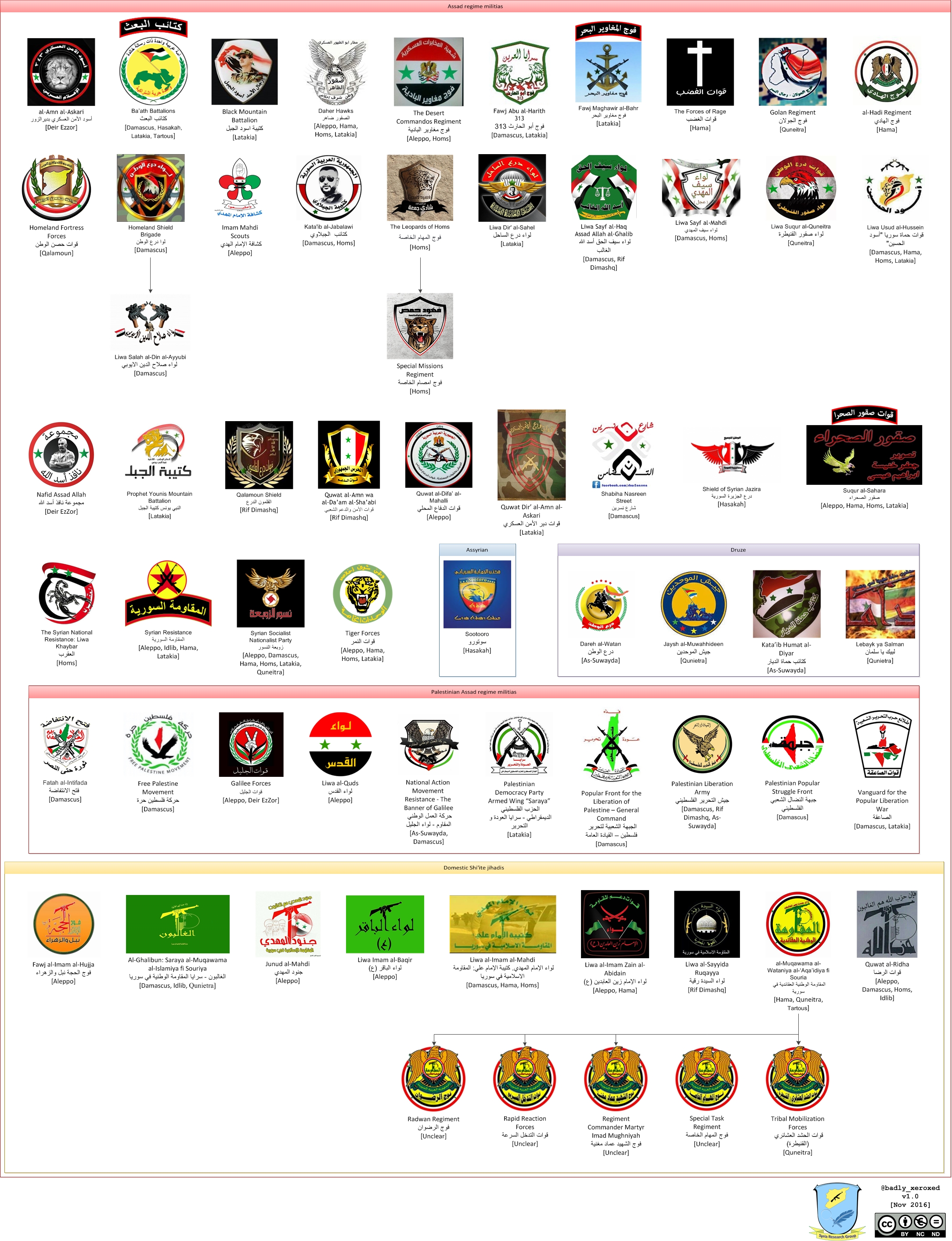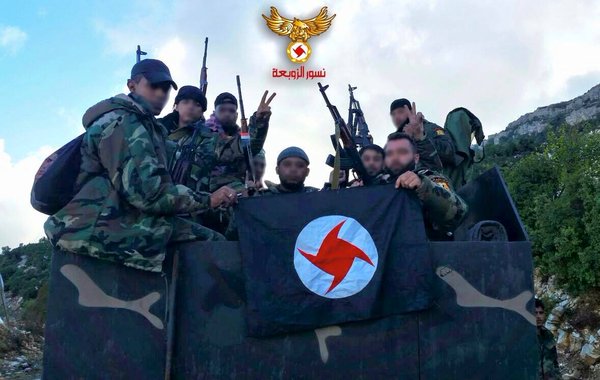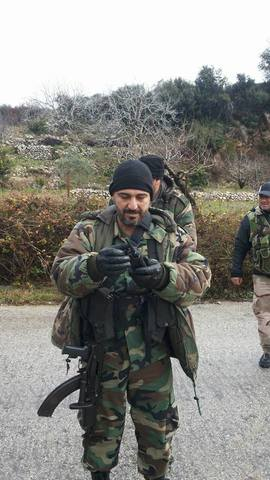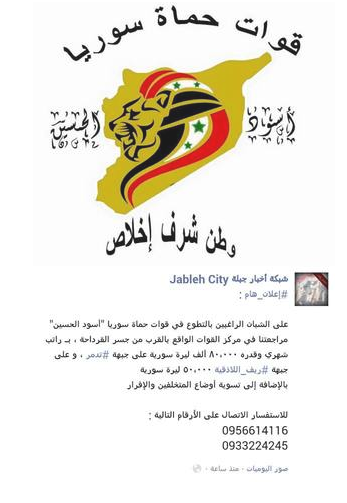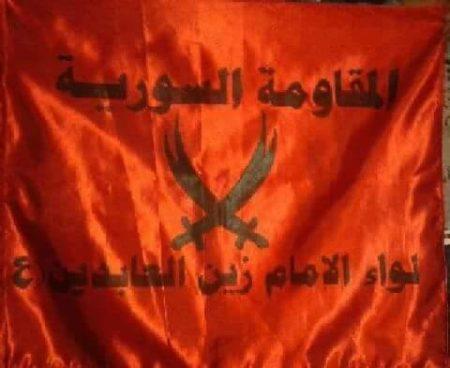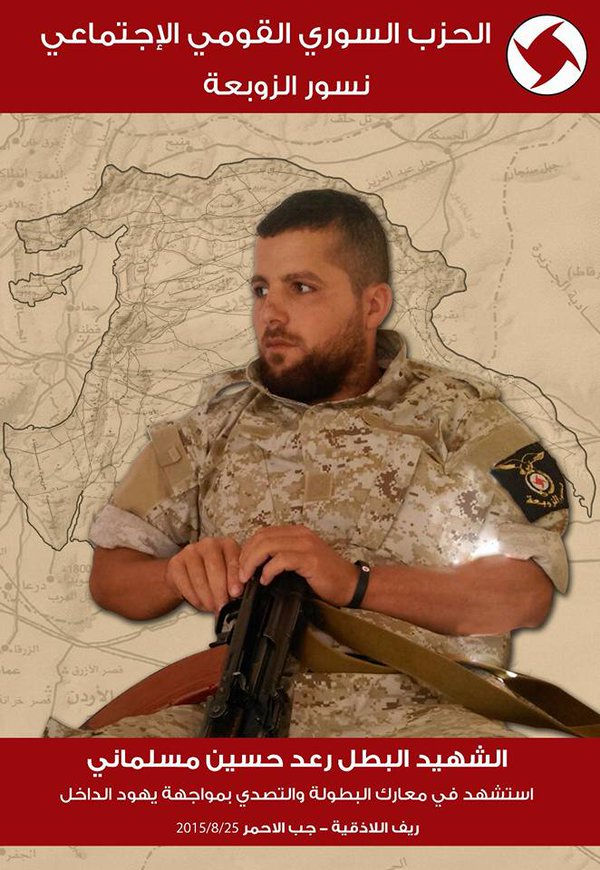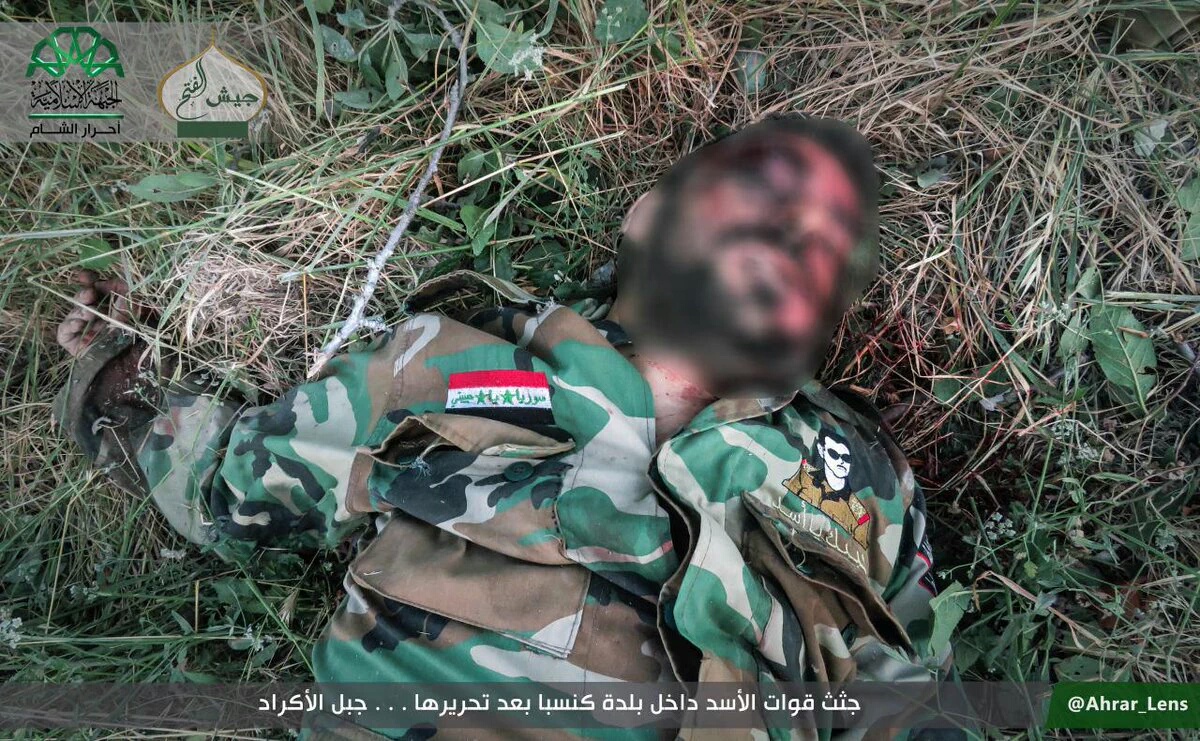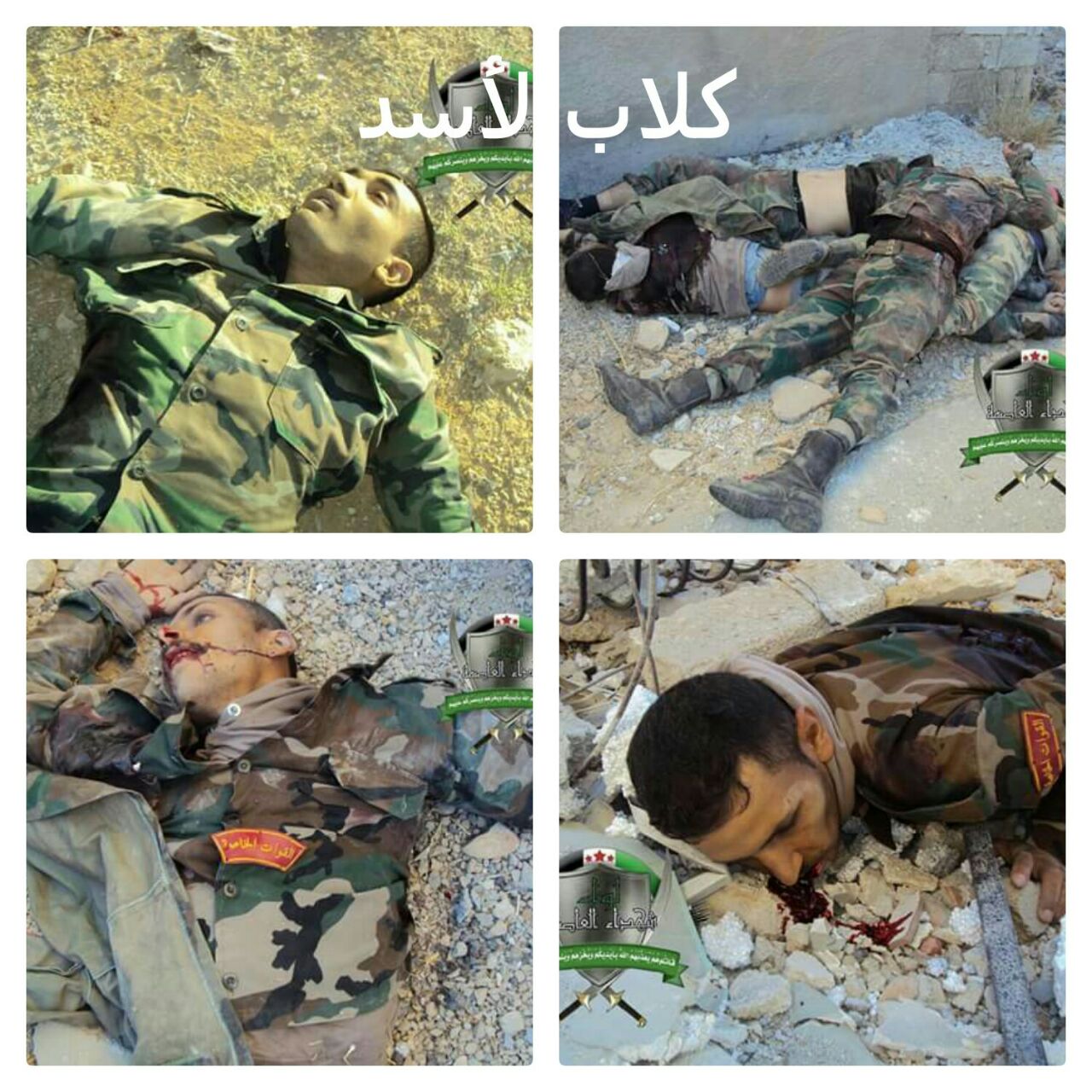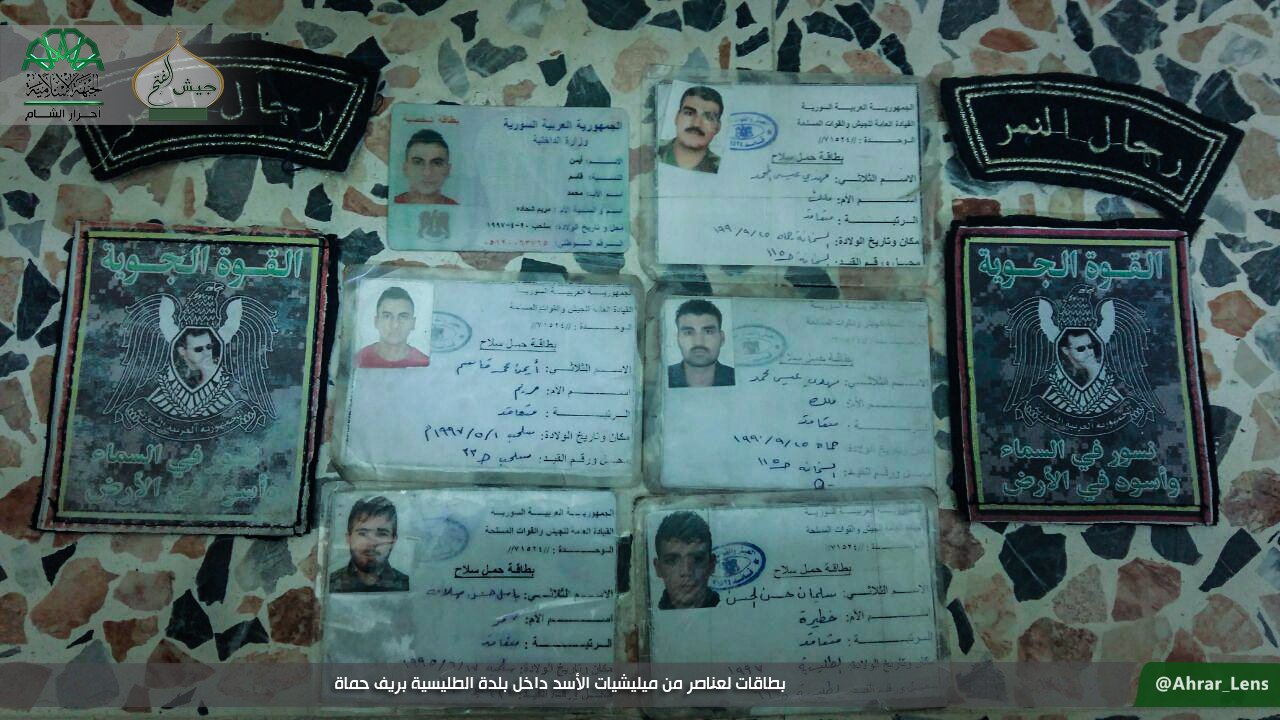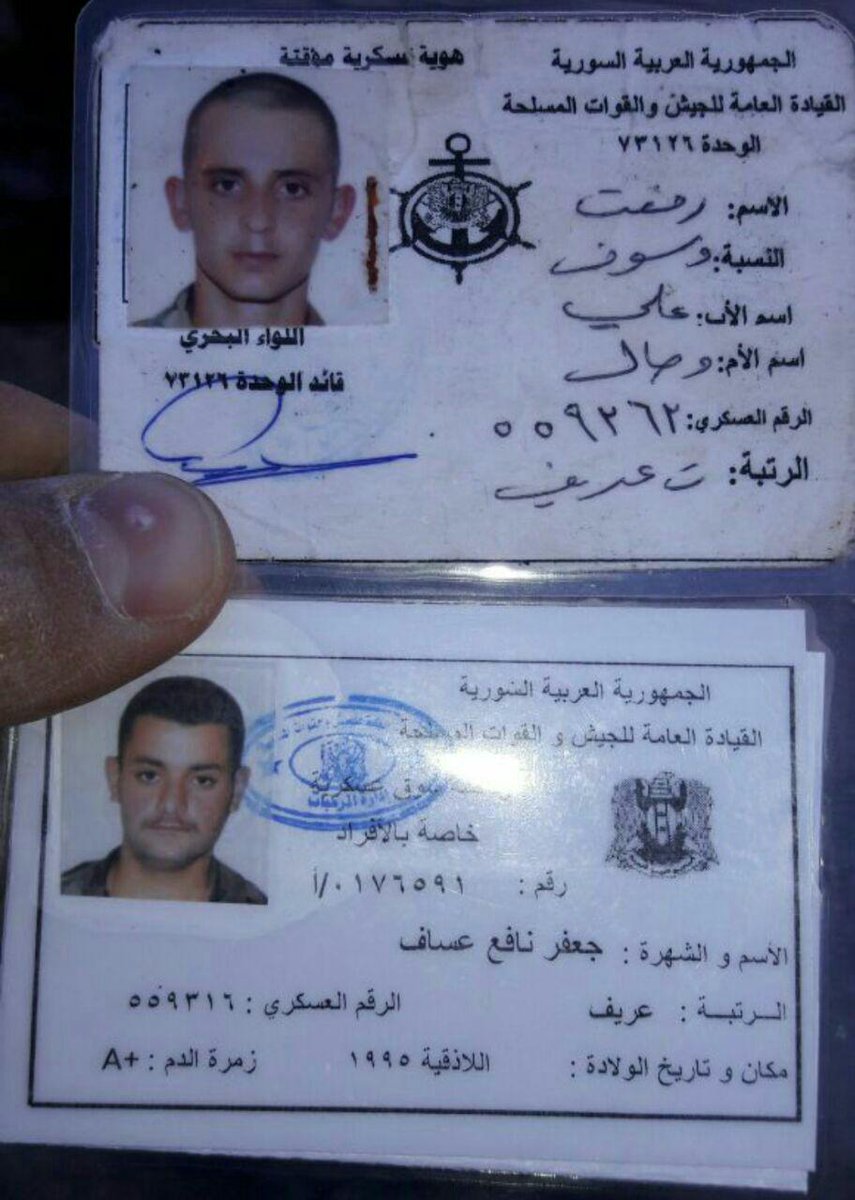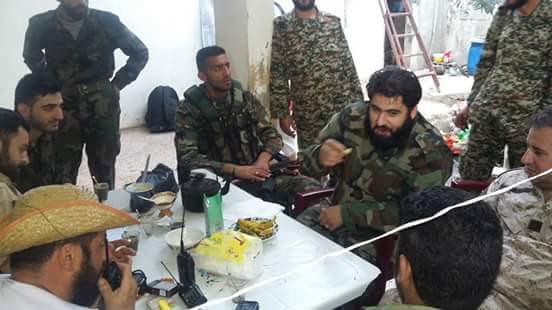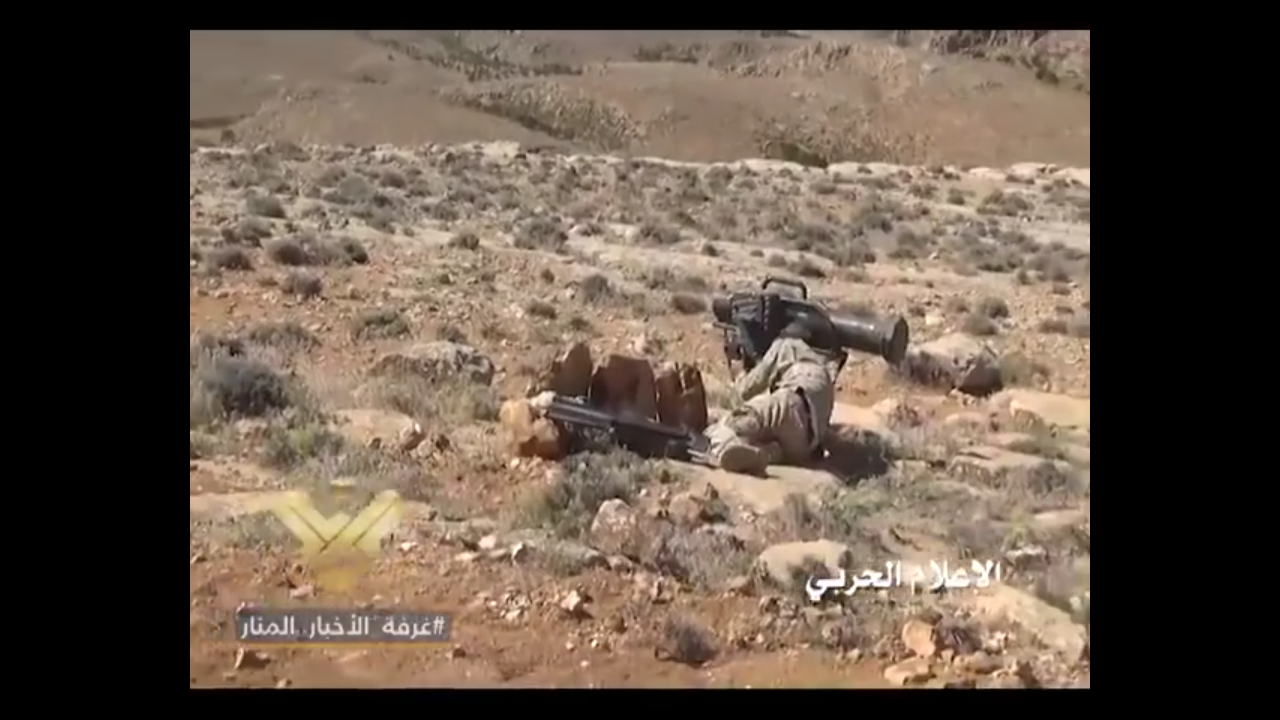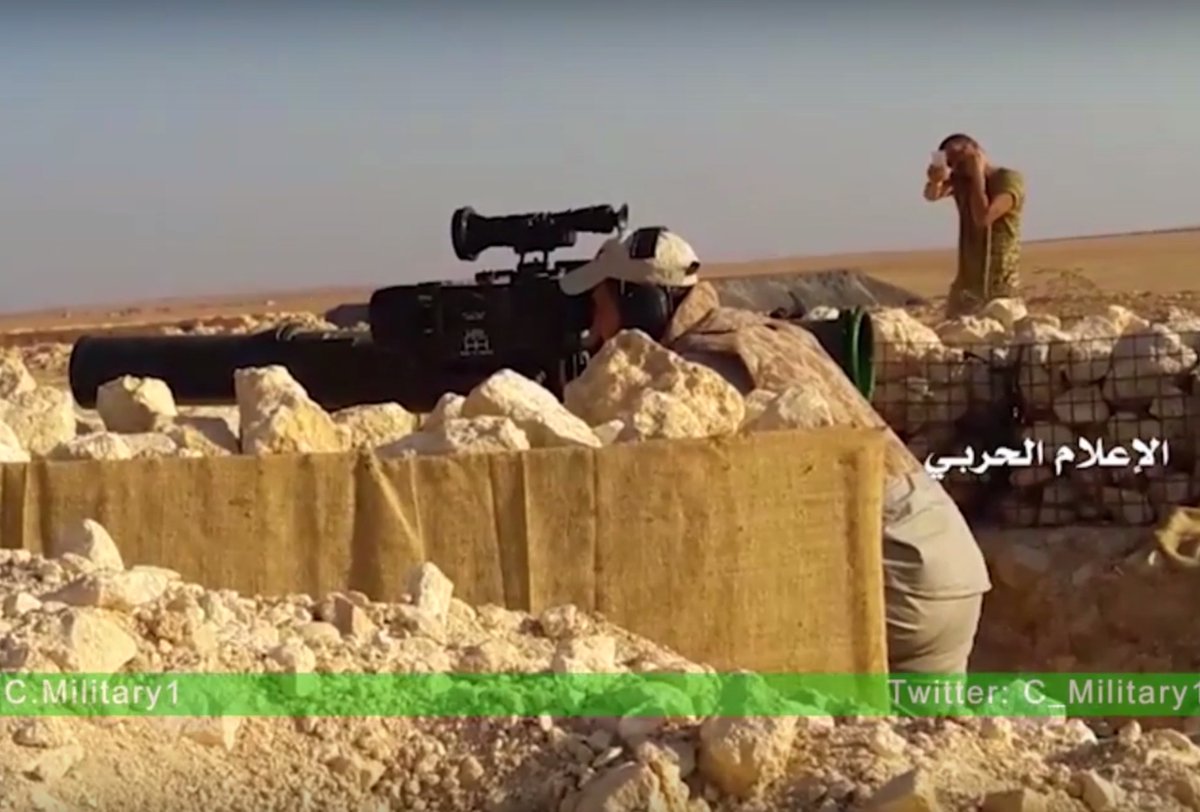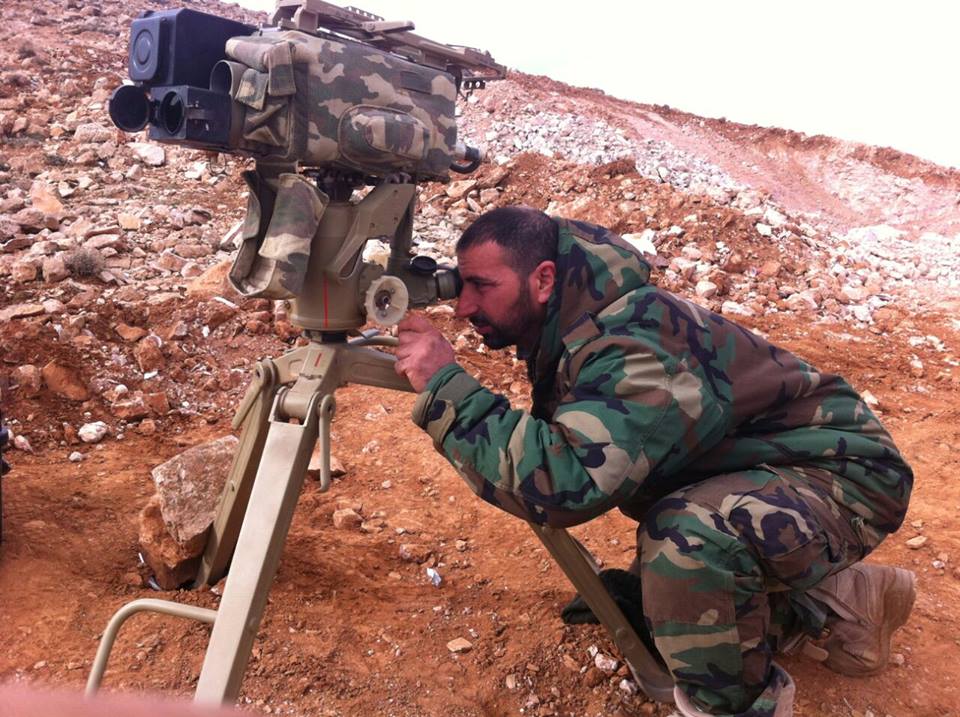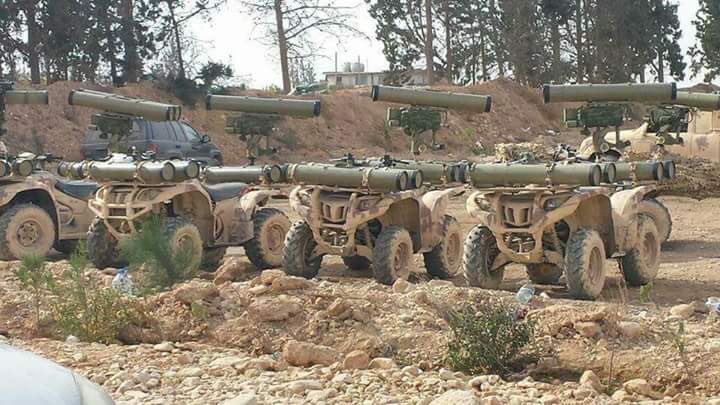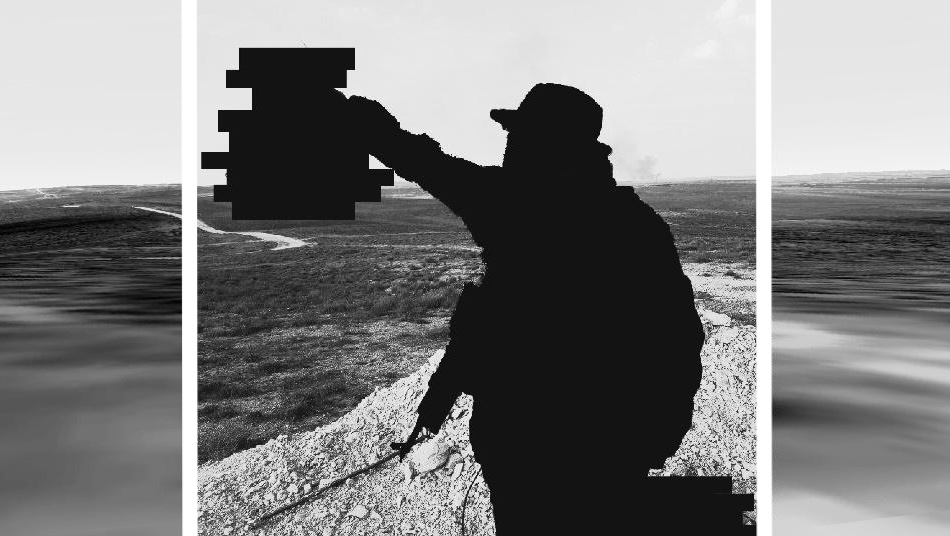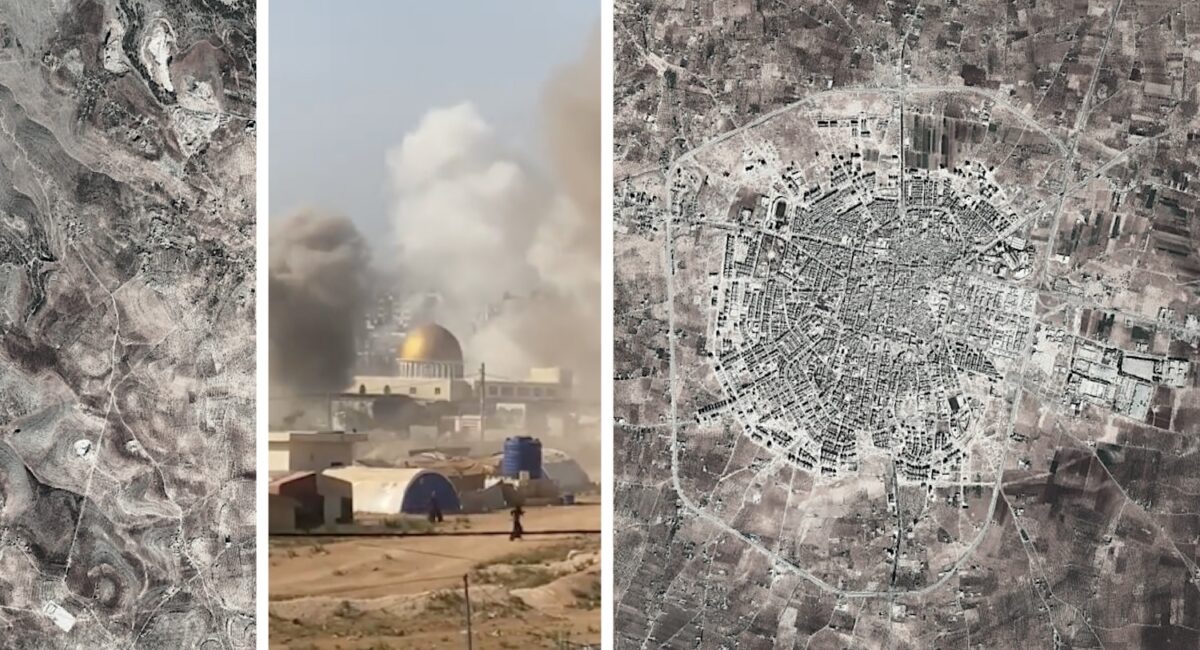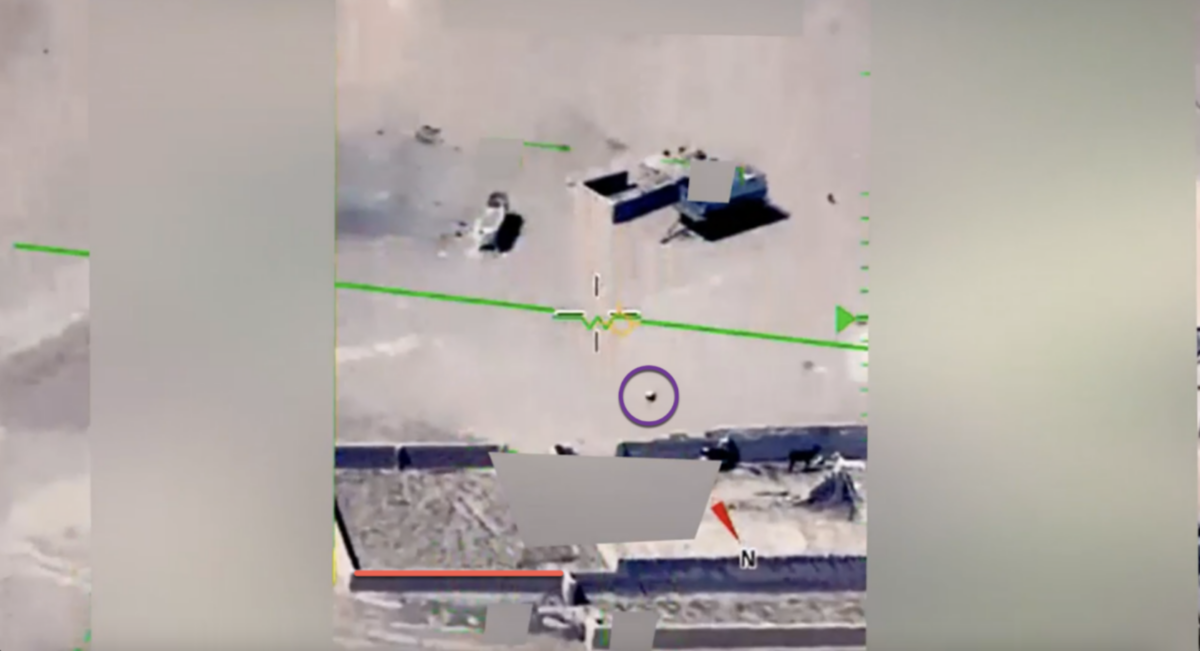Assad Regime Militias and Shi’ite Jihadis in the Syrian Civil War
The following collaboratively written article is the result of months of research in a joint project by Vincent Beshara and Cody Roche. Please save or open images in a new tab to see full details.
Infographic displaying the most visible domestic Assad regime militias in the Syrian Civil War, click the graphic to see it in full resolution
More than five years into the grueling Civil War, the landscape of actors in Syria has only become more complex. Much scrutiny and attention has been focused on the numerous rebel groups that have been spawned by the fighting and their backers. The rise of ISIS, the entrance of the American-led Coalition, and now the Turkish backed Euphrates Shield operation, have all added new actors on the ground to an already complex war. Until recently however, much less attention has been paid to the large array of actors fighting to maintain the Assad regime. For one reason or another, the topic has been largely undiscussed in detail, and when discussed, has been controversial. Yet while it is unclear exactly how many men (and in rarer cases, women) are members of the hundreds of loyalist militias, it is clear that not only is the number of members high, so is their importance—as of March 2015, it was estimated that regime manpower was made up of 125,000 regulars and 125,000 pro-government militia members (with the latter figure including foreign Jihadis fighting for the regime), and almost a year later it seems this balance has likely shifted in favor of the militias. As the situation stands today there does not exist a single front that is entirely held by the SAA. That is true from Deraa, up through Damascus to Aleppo, Hama and Latakia, and even out in the long cut-off outpost in Deir EzZor. We have compiled several infographics with over one hundred Syrian and foreign militia groups, in which every part of Syria is represented. These militias vary in size and importance. Some are no more than a few dozen men, perhaps encompassing and tied to a village or a neighborhood, highlighting the highly regional nature of this conflict on all sides. Other groups field a few thousand men, numerous pieces of armor and artillery, have a national presence, and even their own training camps and networks. Likewise, their ties to Damascus, and more importantly, the level of control Damascus exerts over them, varies.
As foreign support for Assad’s regime has increased, some sources have taken to claiming that the Syrian Arab Army (“SAA”) either no longer exists, or barely exists, with the fight being in the hands of the various foreign militias and military forces that have joined the fighting on Assad’s behalf. The importance of these foreign backers and fighters and the profound influence they have had on the Assad regime should not be ignored, and both their effect and the number of groups involved is eye-catching. From the Iranian and Russian military forces, to Lebanese Hezbollah and the various Iraqi militias, to Afghans and Pakistanis fighting in the Iranian backed groups, it is easy to see why such attention is paid to these groups. These foreigners have played key roles for the regime, including taking the lead in several important offensives. However, to state that foreigners are doing the bulk of the fighting among pro-Assad forces or that the SAA “no longer exists” is as hyperbolic and incorrect as the common regime apologist trope that the Free Syrian Army “no longer exists.” As is the case with the Syrian Opposition, Syrians continue to make up the bulk of the fighters doing most of the fighting, and dying, among pro-Assad forces. That is true across Syria. Likewise, the SAA continues to exist. However, the SAA today is not the SAA that started the war. It is a much diminished shell of itself, mustering less than half the manpower of the pre-Civil War figure of 300,000 and heavily supplemented by localized actors—the regime has “doubled down on the sectarian, tribal, and thuggish inclinations of its base” in order to remain viable. While much has been made of the large number of rebel groups, there has also been an explosion of non-SAA groups (or, militias) fighting on Assad’s side. It is these groups that are the focus of this article.
It is difficult to describe the array of loyalist militias, as they are as diverse as their counterparts among the Syrian Opposition. There are militias that can be described as Nationalists, such as the Homeland Shield Brigade [Liwa Dir’ al-Watan]. There are ethnic militias, like the numerous Palestinian militia groups, and militias organized along sectarian lines such as Shi’ite militia Liwa Imam al-Baqir or one of dozens of Druze militias. Likewise, numerous Alawite and Christian militias exist. There are militias organized along tribal lines, like Ussud al-Sharqiya made up of Shaitat tribe members. At least one all female militia is known to have existed, the Druze Labawat al-Jabal. Armed wings of extremist political parties exist such as the well-known fascist Syrian Socialist Nationalist Party and their Whirlwind Eagles militia [pictured above in Latakia late 2015], as well as that of the Assad regime affiliated Ba’ath Party and its Lebanese branch. Militias tied to outside powers have become increasingly common, like Quwat al-Ridha, one of a number of “Syrian Hezbollah” groups. There are militias which are simply raised and financed by wealthy Syrians, such as the groups created by the Jaber brothers in Latakia. There exist numerous militias who have ties to one of the Syrian intelligence services, or one of the “elite” Syrian military formations. Finally, there exists militias who legitimately would be considered no different than a criminal gang in a time of peace, even by the notorious standards of pre-Civil War Syria.
An example of the latter is Liwa Usad al-Hussein, led by Hassan al-Assad [pictured above]. Hassan’s now deceased father, Mohammed Toufic al-Assad, “founded” Lions of Hussein, a well armed Latakia based militia. Mohammed was nicknamed “Chief of the Mountain,” as before the war since the 80’s he ran smuggling networks in much of Latakia. His group had been tied to kidnappings and extortion. Now with the war, his network has been re-branded as a loyalist militia which has fought everywhere from east Homs to Latakia, although it has continued its criminal activities on the side. As an example of the volatile nature of these types of regime militias, Mohammed Toufic al-Assad met his end in March 2015 with 5 bullets to the head in an intra-regime dispute over influence in Qardaha Latakia. This regime infighting is a recurring theme, as the recent murder of a prominent commander of a Tiger Forces group by other loyalists in Tartous demonstrates. What is left of the regular SAA complain bitterly of the pay imbalance and the incentives militia members are given, stating “How do you not feel oppressed when you see people joining these [reserve] militias and getting paid more than you?” Both regime reporters and pro-regime activists have complained of mass looting by regime militias.
For several reasons, the regime militia infographic is likely a large under count of the actual number of loyalist Syrian militias active in Syria. For one, given the nature of this article trying to visualize groups by presenting logos, we have had to exclude numerous groups we know of that do not have logos. Another issue is the general lack of information on loyalist militias in Syria. Partially due to the lack of attention they have received, observers and media often use the general terms “SAA” or “NDF” to blanket describe any loyalist fighters who are Syrian, ignoring the true composition of forces. This is also due to the lesser amount of emphasis many put on advertising themselves as opposed to how many rebel groups operate. Many groups do not even operate official media pages, let alone produce logos. This is a notable difference to Syrian Opposition groups who meticulously document events such as the formation of new groups, and the use of weapons such as Anti-Tank Guided Missiles and Grads. A key difference found in this project is that the regime militias tend to favor more insular Facebook social media, in stark contrast to the FSA and their embracement of Twitter. As such, the hundred plus logos we have compiled here are undoubtedly a large under count, although they are mostly made up of more important groups. The scope of this article is limited, and as such we will not being taking a close look into any individual group, or group of militias, nor will we look into some of the networks supporting militias. Beyond highlighting the existence and importance of pro-Assad militias, this article will look at the use of heavy weapons by loyalist militias, direct Russian involvement with the militias and the presence of Syrian as well as foreign Shi’ite sectarian militias.
Other domestic regime groups, flags, patches and martyrdom posters
Maghaweer on Qummat Nabi Younis is a pro-Assad regime group made up of suicide bombers from Latakia, and a subgroup of NDF affliated militia Prophet Younis Mountain Battalion, formed around December 2014
Liwa al-Imam Zain al-Abidain, a small regime militia active in Deir EzZor named after a Shia religious figure and thought to be affiliated with Hezbollah
A SSNP martyrdom poster from August 2015 for a militia fighter KIA in Latakia, making reference to the struggle against the “internal Jews” [the SSNP’s terminology for opponents of the Assad regime]
An Ahrar al-Sham image showing a regime militia member with a patch depicting Bashar Assad’s head, as well as another patch of the Ba’athist pan-Arab Syrian flag with a Nationalist slogan “Sooria Ya Habibati” defacing it—the image is from Latakia [June 2016]
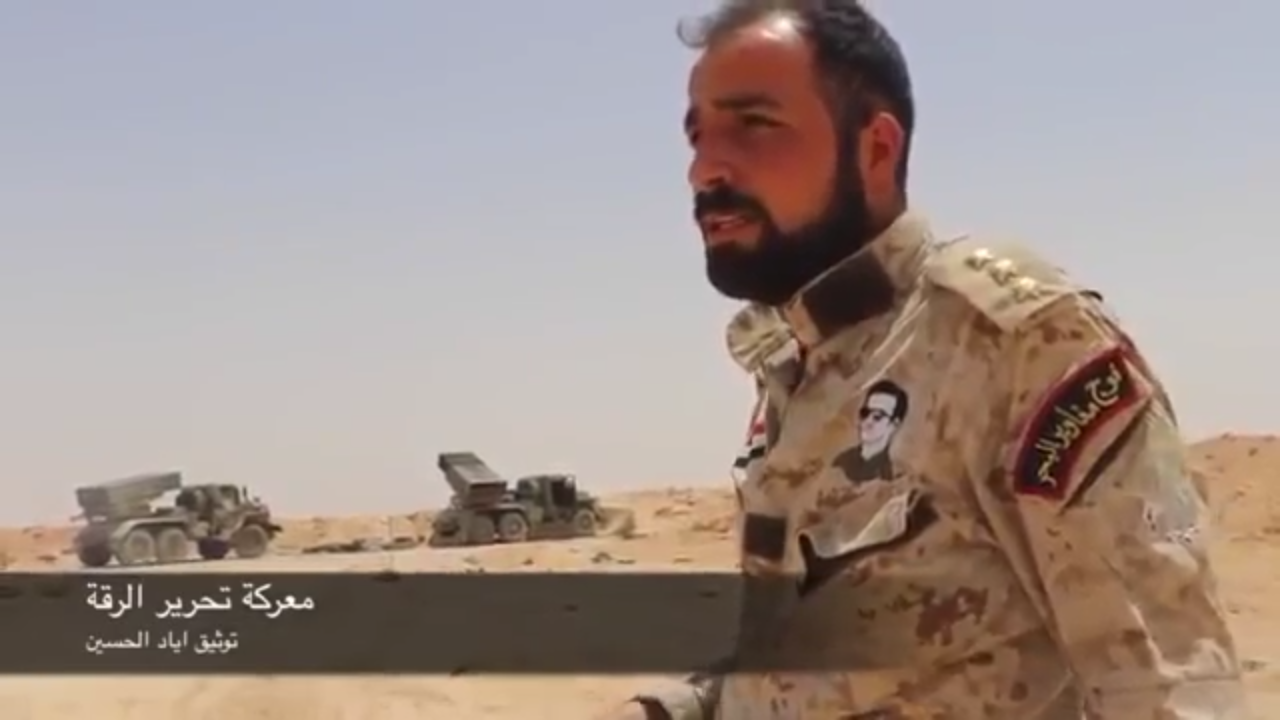
A Fawj Maghawir al-Bahr [Naval Commandos] militia member in Homs during the failed Raqqa offensive, with another example of the popular patch crudely depicting Bashar Assad’s head [June 2016]
FSA Shohadaa Al-Asima Brigade images showing regime KIA with al-Quwat al-Haras [Guard Forces] patches from Rif Dimashq [September 2016]
An Ahrar al-Sham image from Hama showing Rajal al-Nimr [Tiger Men/Men of the Tiger] patches on top and Quwa al-Jowiya [“Air Force,” most likely the infamous Air Force Intelligence Directorate] patches on the bottom taken from KIA regime fighters [September 2016]
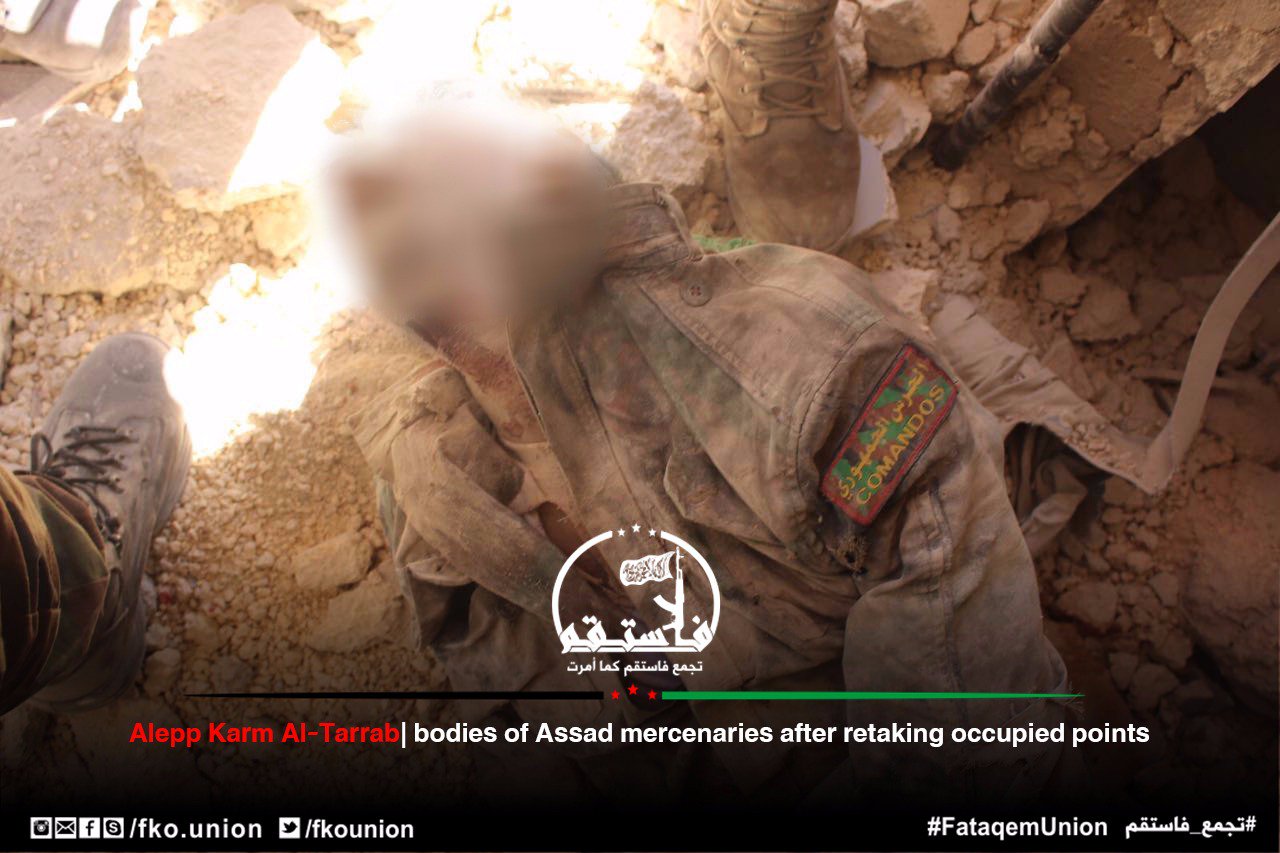
A FSA Fastaqem Union image from Aleppo showing a KIA regime militia member with a “COMANDOS [sic]” patch [October 2016]
The top ID card in the above image is of a KIA member of the Fawj Maghawir al-Bahr [Naval Commandos] militia, Latakia [November 2016]
Notable regime militia figures
Bassel al-Assad [sitting center eating in image], KIA former leader of al-Hadi Regiment
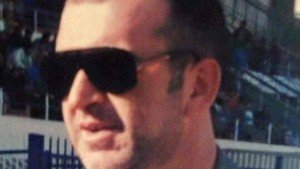
Fawaz Jamil al-Assad, deceased paternal cousin of Bashar al-Assad. who along with Munther al-Assad was one of the two main leaders of the early shabiha in Latakia—passed away in March 2015 from Chronic Liver disease
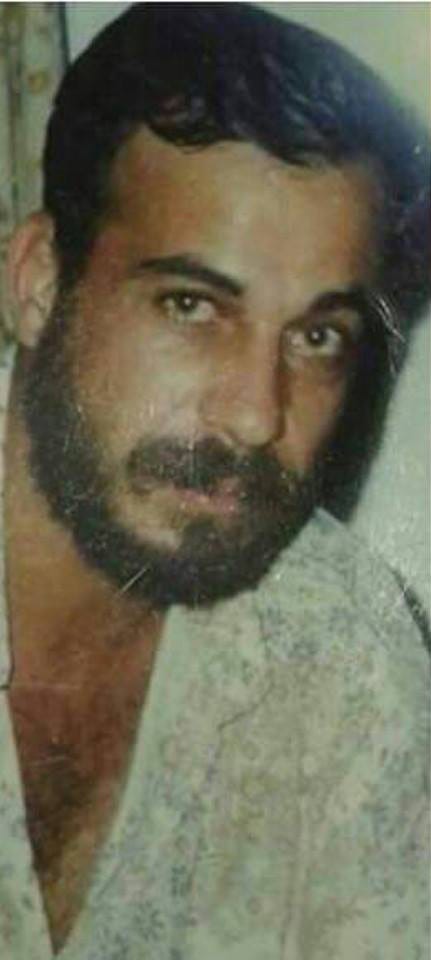
Mohammed Toufic al-Assad is a deceased Assad associate nicknamed “Chief of the Mountain” who was a smuggler, shabiha, founder of The Lions of Hussein Brigade [Liwa Usud al-Hussein] and father of the militia’s aforementioned current leader Hassan al-Assad
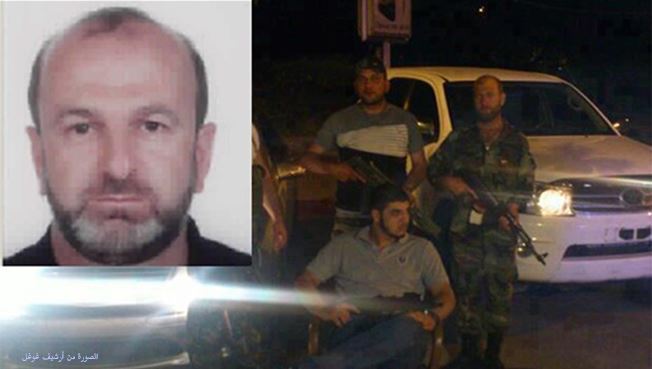
Munther al-Assad, paternal cousin of Bashar al-Assad, one of the main early leaders of the shabiha in Latakia along with Fawaz al-Assad, and participated in the creation of the NDF; he was arrested for a period in April 2014, and more recently fought skirmishes with Aymen Jaber in Latakia July 2016
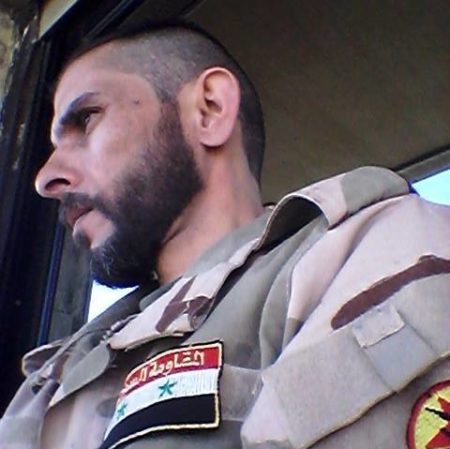
Zaher Hasan al-Asad, leader of the Shi’ite Liwa al-Imam Zain al-Abidain, with a patch on his arm of the emblem of the Syrian Resistance Front, as well as a Syrian Ba’athist flag patch with the Arabic text “Resistance” [مقاومة] visibly defacing it appearing on his chest—a notable example of the syncretism often on display between far-left and Shia religious imagery
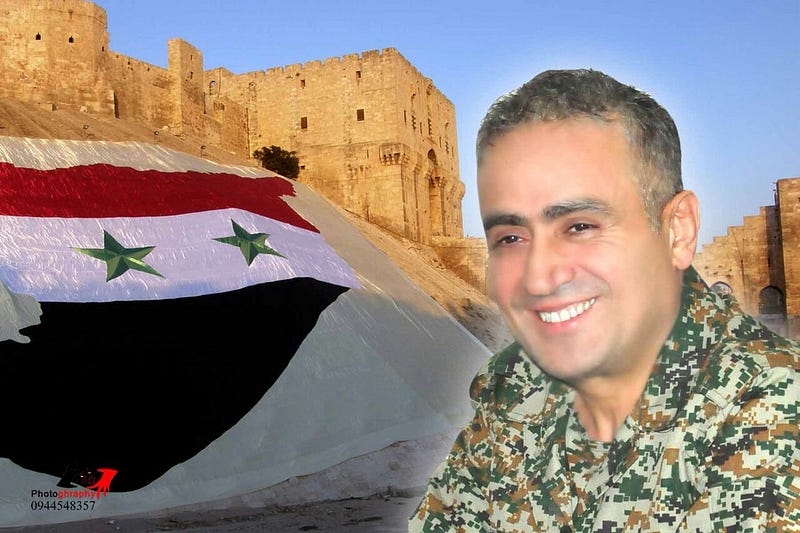
Sami Aubery, leader in the Aleppo NDF
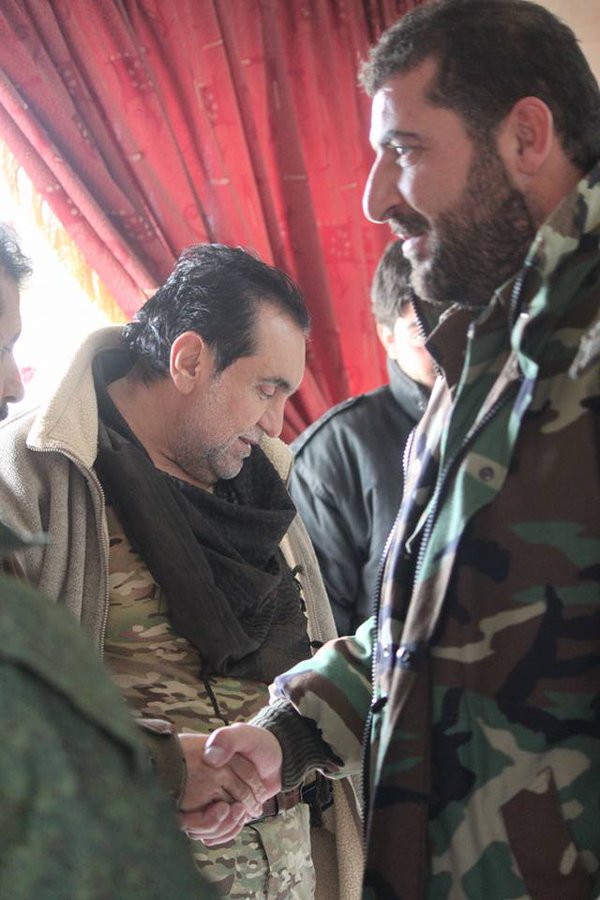
Salah al-Assi of the village of Tayr Jamlah near Masyaf City Hama is a militia figure associated with both his own private militia, known as “Salah al-Assi’s Forces,” as well as the Tiger Forces—he has come to attention lately as an infamous looter
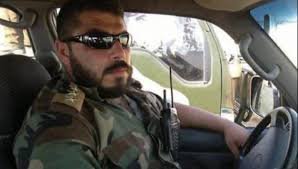
Talal Dakkak is a shabiha figure from Hama, known as an individual Suheil al-Hassan coordinates with in Hama City
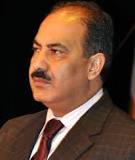
Hilal Hilal is a career politician and Baathist who formed what are now the Ba’ath Brigades in the summer of 2012 in Aleppo

Abu Ja’afar AKA “The Scorpion of Homs” [left of image] who organizes The Syrian Nation Resistence: Liwa Khaybar
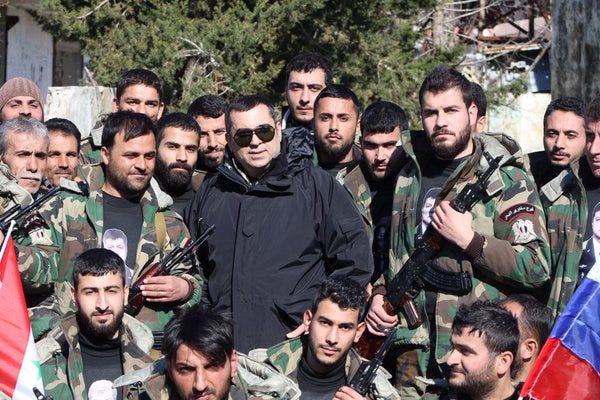
Ayman Jaber [middle of image] who leads the Naval Commandos militia, one half of the “Jaber brothers”

M. Jaber who leads the Desert Falcon militia, the other half of the “Jaber brothers”
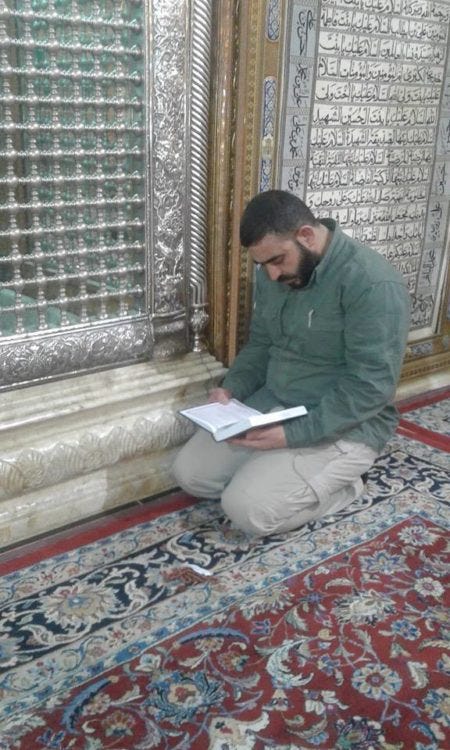
Khalid al-Hassan of the Bekara Clan, involved with Shia Jihadi group Liwa Imam al-Baqir

Suheil al-Hassan — promoted by regime propaganda as “The Tiger”—is the leader of the Tiger Forces militia, notorious for ordering his troops to open fire on protesters early in the Syrian Revolution (al-Hassan was also recently included in a list of regime commanders accused of doing so by United States UN Permanent Representative Samantha Powers) and well known for leading what are generally regarded as one of the last “elite” forces the regime still commands [along with the Republican Guard], seen here receiving the Order of Friendship award from the Russian Federation at Hmeymim Airbase Latakia in late 2016

An old image of Suheil al-Hassan from July 2014 is worth including as he now looks considerably different, either due to plastic surgery from a severe injury or possibly due to having been killed in action and replaced by a body double

Rami Makhlouf, hugely corrupt regime businessman and member of the Assad regime inner circle, with links to Dara’ Qalamoun, Katai’ib al-Jabalawi, Leopards of Homs and Dir’ al-Watan militias
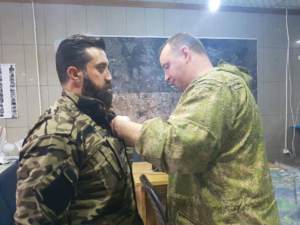
Liwa al-Quds Commander of Operations Mohamed Mahmoud Rafi [AKA “The Godfather”], seen here being awarded the “Medal of Military Cooperation” by a Russian officer, was KIA in the regime assault on besieged East Aleppo 2016-11-27

Ali Shelly, a Tiger Forces militia unit commander and shabiha crime figure from North-West Hama
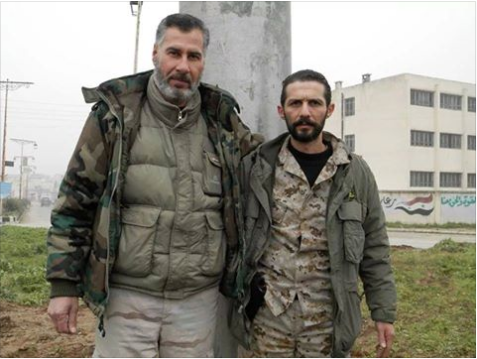
Philip Suleiman [left of image] of The Forces of Rage
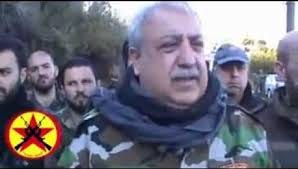
Mihrac Ural AKA Ali Kayal is a far-left figure and Turkish Alawite, well known for his role in the Bayda and Baniyas massacre in Tartus, leads the Syrian Resistance militia

Issam Zahreddine is a Druze General active on the Deir EzZor front. He appears on the logo of the Nafid Assad Allah militia, which is likely more akin to his personal retinue
Proliferation and use of heavy weapons among regime militia
The proliferation of weapons to non-SAA loyalist fighting groups has included almost every major weapon system in the SAA pre-war arsenal, along with many weapons since delivered by Iran and Russia. These include multiple variants of T-55/54, T-62, T-72, and T-90 tanks, BMP-1’s, 2S1 Gvozdika’s, ZSU-23-4’s, ATGM’s, and multiple types of towed and rocket artillery among other weapons. Even the best examples of armor the regime has access to have proliferated to militia, including T-90A’s used by IRGC backed Shi’ite militias, to Suquor al-Sahara’s recently seen T-90A and T-72B obr.1989 with Kontakt-5 ERA. Interestingly, the proliferation of towed tube artillery and major rocket artillery systems seems to have lagged behind the proliferation of armor and ATGM’s, although this seems to be changing.
Below is a small collection of media broken down by three categories: armor, artillery and ATGMs. We have included some picture examples to give an idea of how common the proliferation of heavy weapons to non-SAA actors has become. We have not included other weapon systems such as recoilless rifles or technicals, of which there are many. Similarly, we have not included examples of IRAMs or “hell-cannon” type improvised weapons, which are very common among regime militia and are easily recognizable.
Armor
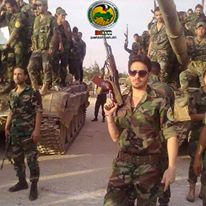
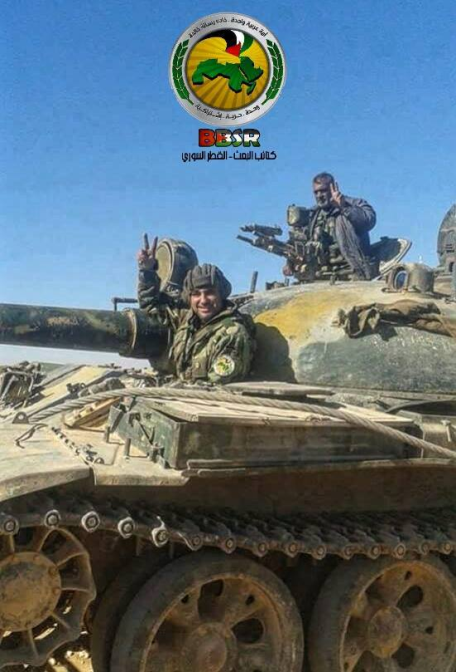
Ba’ath Brigades pictured with tanks, locations unknown [left to right: June 2015 and February 2016]
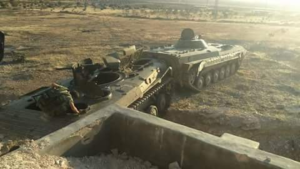
Ba’ath Brigades BMPs, location unclear [September 2016]

Fatah al-Intifada BMP [September 2016]
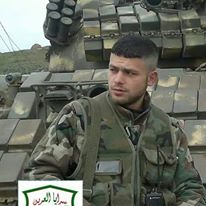
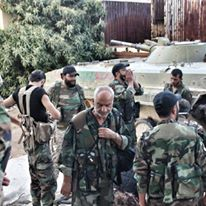
Fawj Abu al-Harith tank and BMP in Aleppo [left] and Hama [right] [September 2016]
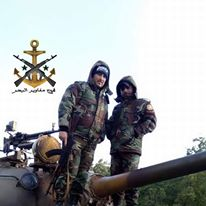
Fawj Maghawir al-Bahr [Naval Commandos] tank likely in Latakia [July 2016]
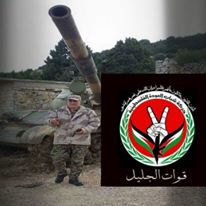
Galilee Forces [April 2016]
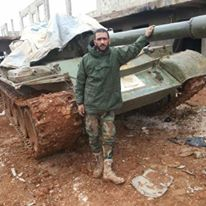
al-Hadi Regiment tank, location unclear [December 2015]
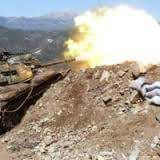
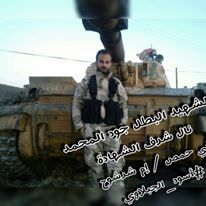
Kata’ib al-Jabalawi [January 2016, April 2016]
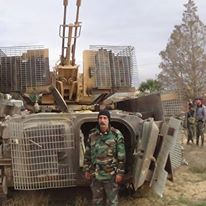
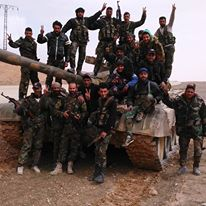
The Lions of the Eternal Leader BMP and tank [left to right: January 2015, May 2016]
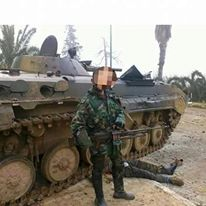
Liwa Dir’ al-Sahel [Coastal Shield Brigade] [October 2015]
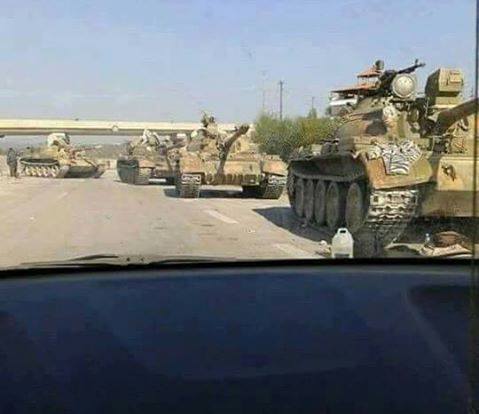
Liwa Imam al-Baqir “Armored Brigade” in Aleppo featuring at least four tanks [April 2016]
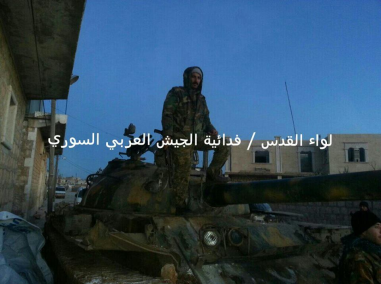
Liwa al-Quds tank location unclear [January 2015]
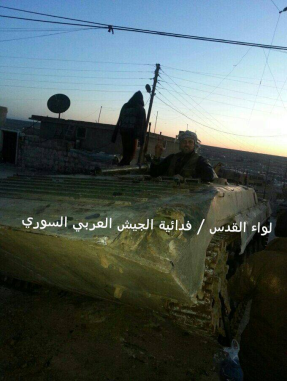
Liwa al-Quds BMP location unclear [January 2015]
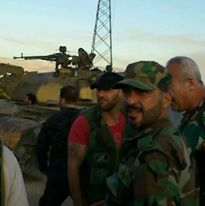
Liwa Usad al-Hussein tank [July 2015]

The Leopards of Homs tank, location unclear [September 2016]
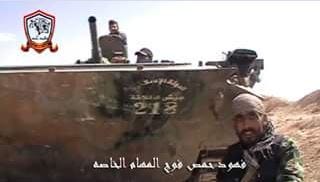
The Leopards of Homs BMP location unclear [May 2016]

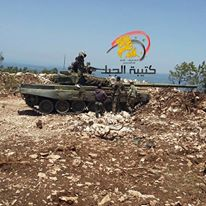
Prophet Younis Mountain Battalion tanks Latakia [left to right: December 2015, June 2016]

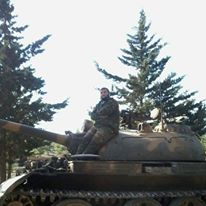
National Ideological Resistance BMP and tank [left to right: January 2016, March 2016]

Qalamoun Shield tank [October 2016]
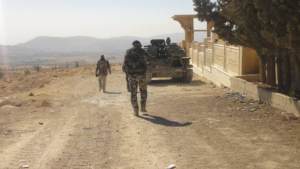
Qalamoun Shield ZSU-23-4 AKA “Shilka” [November 2016]

Quwat al-Ghadab [October 2015]
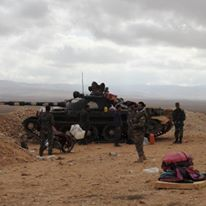
Sootoro tank [November 2015]
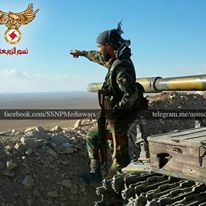
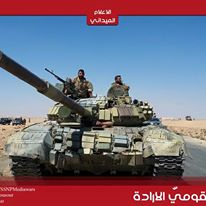
SSNP tanks [left to right: May 2016, August 2016]
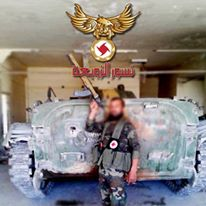
SSNP BMP [May 2015]
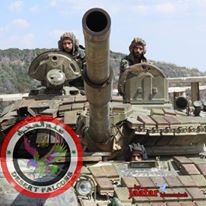
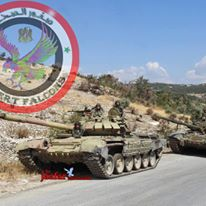
Suqur al-Sahara [Desert Hawks] tanks with ERA visible Latakia [September 2016]
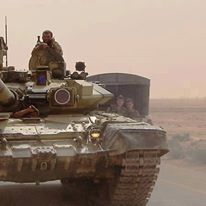

Suqur al-Sahara spotted alongside a T-90—ownership unclear—during failed “Road to Raqqa” offensive [June 2016]
Artillery
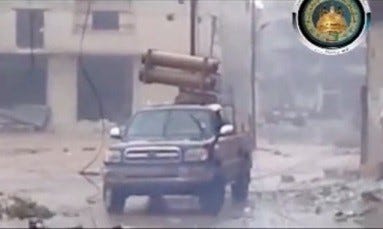
Brigade of Abu al-Fadl al-Abbas/al-Abbas Brigade MRL, location unclear [Date unknown]


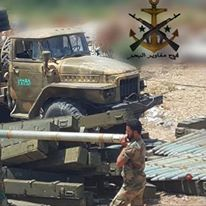
Fawj Maghawir al-Bahr [Naval Commandos] Grads, likely in Latakia [July 2016]
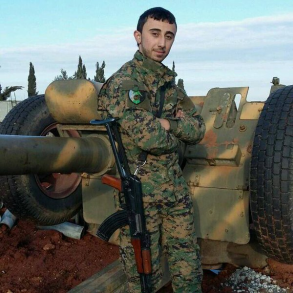

Islamic Resistance Brigades in Syria artillery and Grad launcher [September 2015]
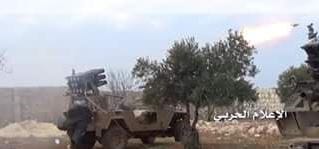
Leopards of Homs MRL [April 2016]
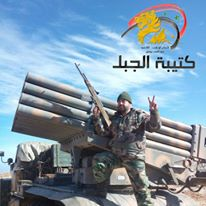
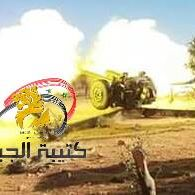
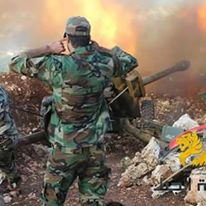
Prophet Younis Battalion Grad launcher and artillery in Latakia [left to right: February 2016, June 2016]
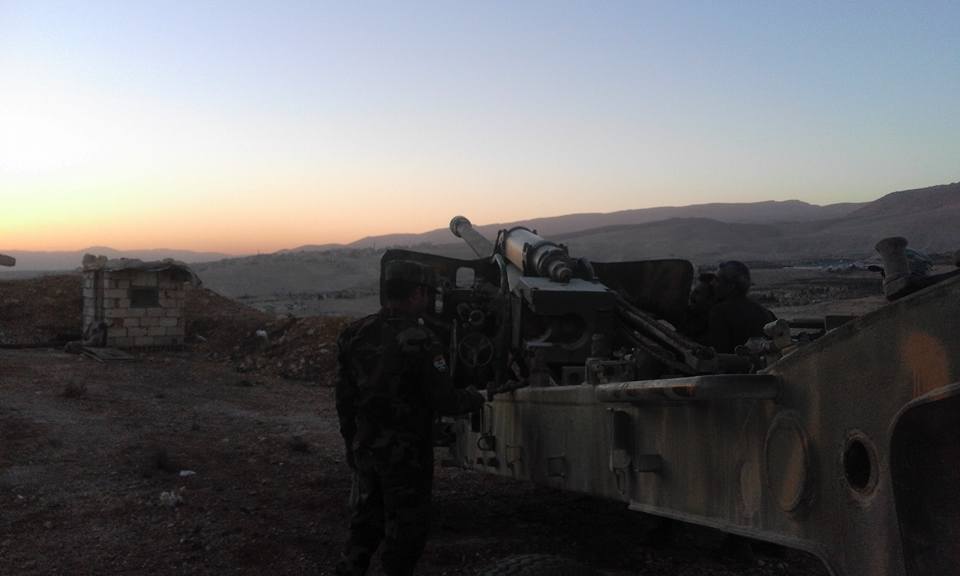
Qalamoun Shield artillery piece [November 2016]

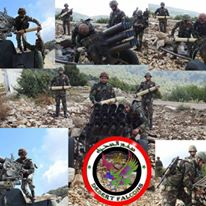
Suqur al-Sahara [Desert Hawks] Grads and MRLs, likely Latakia [September 2016]
Anti-Tank Guided Missiles [ATGMs]
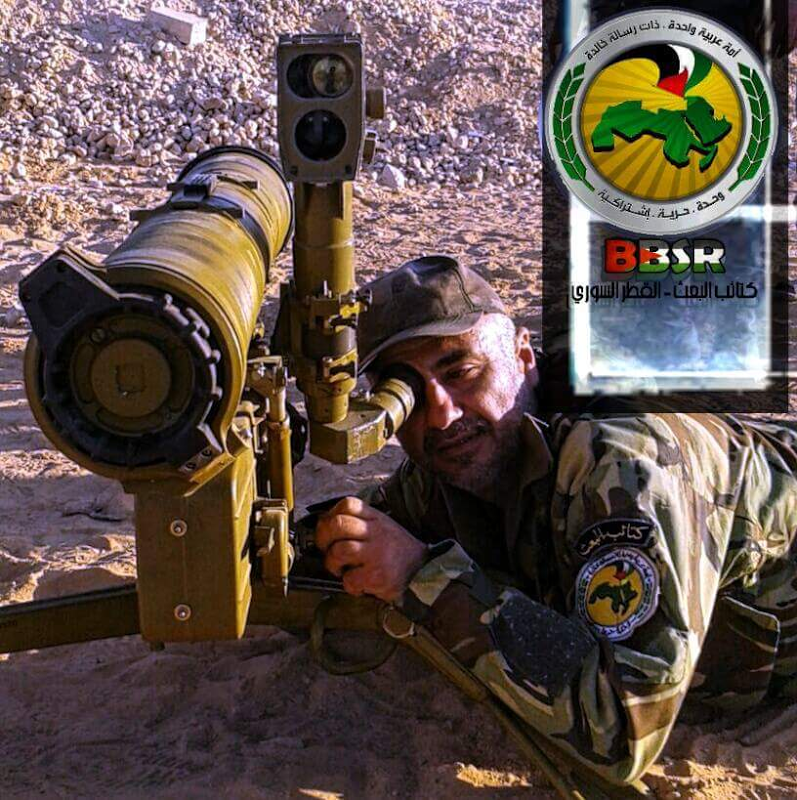
Ba’ath Brigades member operating a Konkurs ATGM, NATO designation AT-5 Spandrel [February 2016]

Fawj Abu al-Harith 313 operating a Fagot/Konkurs ATGM launcher likely in Latakia [August 2016]


Fawj Maghawir al-Bahr[Naval Commandos] operating Fagot/Konkurs ATGMs in Latakia [left to right: July 2016, April 2016]

The Leopards of Homs operating a Fagot ATGM, NATO designation AT-4 Spigot [April 2016]
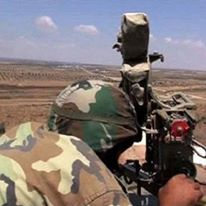
The Lions of Hussein Brigade operating a Fagot/Konkurs ATGM launcher [August 2016]

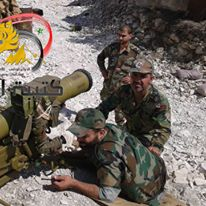
Prophet Younis Mountain Battalion operating Fagot/Konkurs ATGMs in Latakia [July 2016]
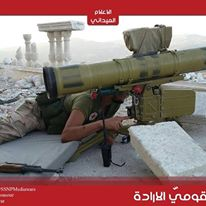
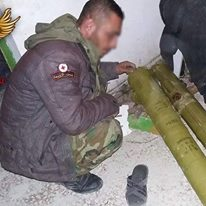
SSNP operating a Konkurs ATGM and in possession of Fagot ATGMs, locations unclear [left to right: July 2016, February 2016]
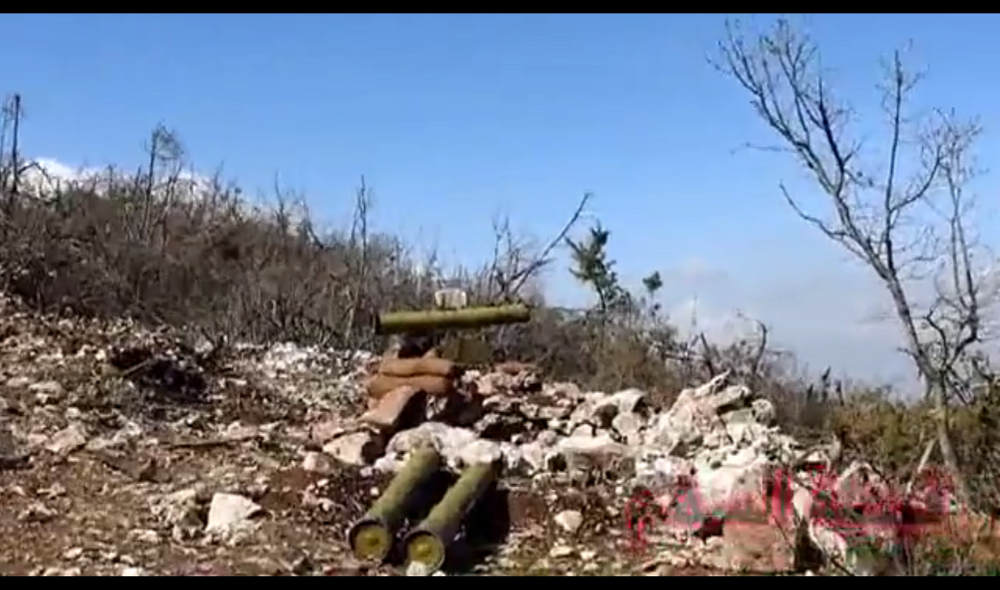
Suqur al-Sahara [Desert Falcons] operating a Fagot ATGM, in Latakia [March 2016]
Russian influence on Syrian militias
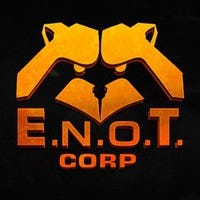

Much has been made of Russian involvement in the Syrian Civil War, with 4,000 Russian personnel thought to be active in Syria including several Private Military Companies [E.N.O.T Corp and Morgan Security Group PMC logos pictured above, both companies active in Syria]. While most commentary has focused on the efforts of the Russian air force and Russian support for the SAA, recently some commentators have started noticing Russian ties to pro-Assad militias. Russian ties to Liwa al-Quds for example, the well-known pro-Assad Palestinian militia in Aleppo, have been the subject of two recent articles, one by The Long War Journal and another by Conflict Intelligence Team. How strong ties between Russian and non-state loyalist actors in Syria are, and what exactly those ties consist of, is difficult to tell. It is clear however, that such ties are increasing, as Russian officers and soldiers are seen more and more with various militia groups in Syria. Further, the influence of Russia’s intervention is noticeable. Increasingly, Russian imagery- from the Russian flag to symbols representing Russia-, and Russian messaging is appearing on media and social media linked to pro-Assad militia groups. The awarding of Russian medals to militia members, when it happens, is prominently displayed and celebrated, and some groups have even added some Russian to their pages.
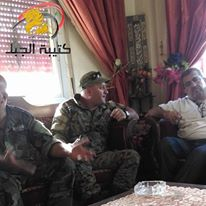
Early examples of Russian interaction with pro-Government militias date back to at least August of 2015, although they are more limited. Pictures exist of Russian soldiers and officers interacting with the Prophet Younis Mountain Battalion, a Latakia Based pro-Assad militia.
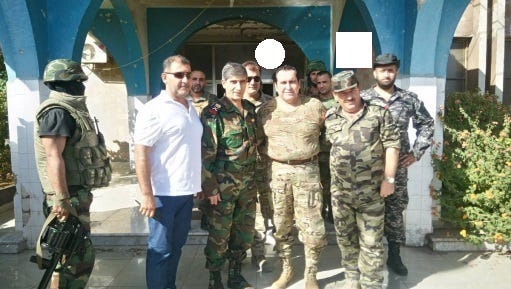
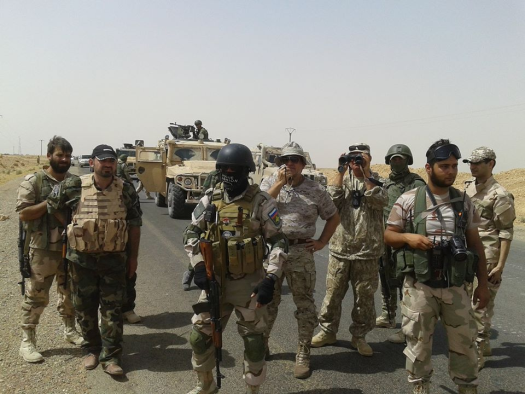
The most common early examples of Russian interactions with pro-Assad militias are with the Jaber groups, pictured above with Desert Hawks on the left [September 2016] and the Sea Commandos/”Navy Seals” on the right [June 2016].
Evidence suggests Russian involvement with these Jaber groups is higher than with any others, including potentially the supply of some weapons, as recent video footage from Aleppo shows [shown above from November 2016]
Russian involvement has become particularly notable in Aleppo in recent months, something highlighted by the recent CIT and Long War Journal articles looking at Liwa al-Quds. Three of the most important pro-Assad groups in Aleppo, likely the three largest contributors of manpower on the government side, are Liwa Imam al-Baqir, Liwa al-Quds and the Ba’ath Brigades [Pictures above from an awards ceremony run by Russian officers for al-Quds members in the end of October 2016]. Russian ties with all three appear to be growing. Pictures of Russians with Al-Quds members exist from as early as March 2016. Russians are known to have met with with al-Baqir in May 2016.
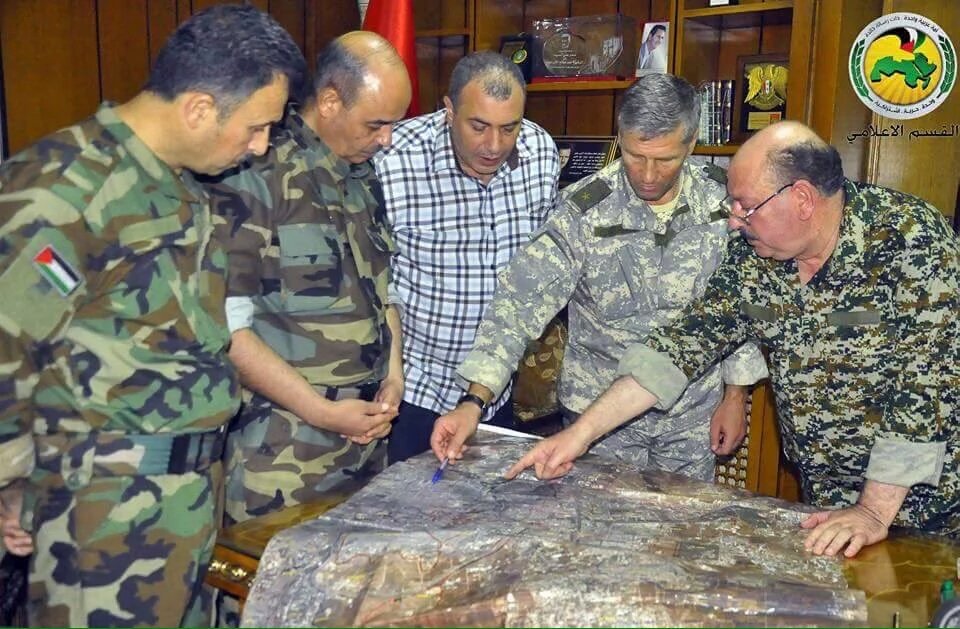
In the past few months, Russian involvement with these Aleppo groups has notably increased. Russian officers have on several occasions been seen in the command centers for all three organizations. Likewise, key officers and commanders from these groups have been recently seen receiving Russian awards. Evidence does not suggest that ties between Russia and these major include the distribution of weapons, or financial support. In fact, al-Baqir and al-Quds in general appear to be less well armed than some other pro-Assad militias. The evidence does suggest some level Russian influence and involvement in planning and directing operations by these three groups. Given Russia’s heavy involvement in Aleppo operations, it makes sense that Russia would become more directly involved with these groups as they are key elements of operations in the area. As Aleppo operations continue, and Russian involvement deepens, it will be interesting to see if these ties broaden to include the delivery of newer weapons directly to these militias, or if evidence of financial ties emerge.

On a lesser scale, Russia has been seen to be involved with even minor militias and groups. Seen here with commanders from a small local militia based in the town of Seghata, Hama in the summer of 2016.
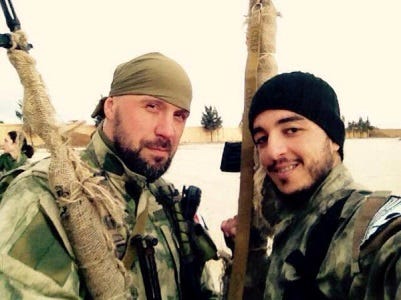
And here a Russian is seen with the Sootooro in Qamishlo.
While it is difficult to measure the true extent of Russia’s direct involvement with militias and non-SAA groups in Syria, it is clear that such ties both exist and are expanding. It is likely that as Russia continues to become more involved in the Syrian Civil War, Russia will find itself working more and more directly with non-SAA groups to accomplish its goals. What will be interesting to see, is if Russian involvement with militias extends in the future to militias based in south Syria. So far, most evidence points to Russia becoming directly involved with groups based in the north of the country. Specifically in Latakia, Aleppo, Hama, and Eastern Homs. While less active in Southern Syria such as Damascus, Daraa, Quneitra and Suweida where many militias also exist, FSA Shuhada al-Islam of the recently forcibly displaced Darayya area did report Russian advisor involvement during the last days the pocket was able to defend itself against the regime.
7
كما استخدمت تقنيات جديدة للإستطلاع تستخدم لأول مرة وباشراف ضباط وخبراء روس، تمكنت من خلالها قوات النظام البرية والميليشيات المساندة لها— لواء شهداء الإسلام (@ShuhadaAlislam) August 13, 2016
Presence of external Shi’ite Jihadis and other foreign fighters
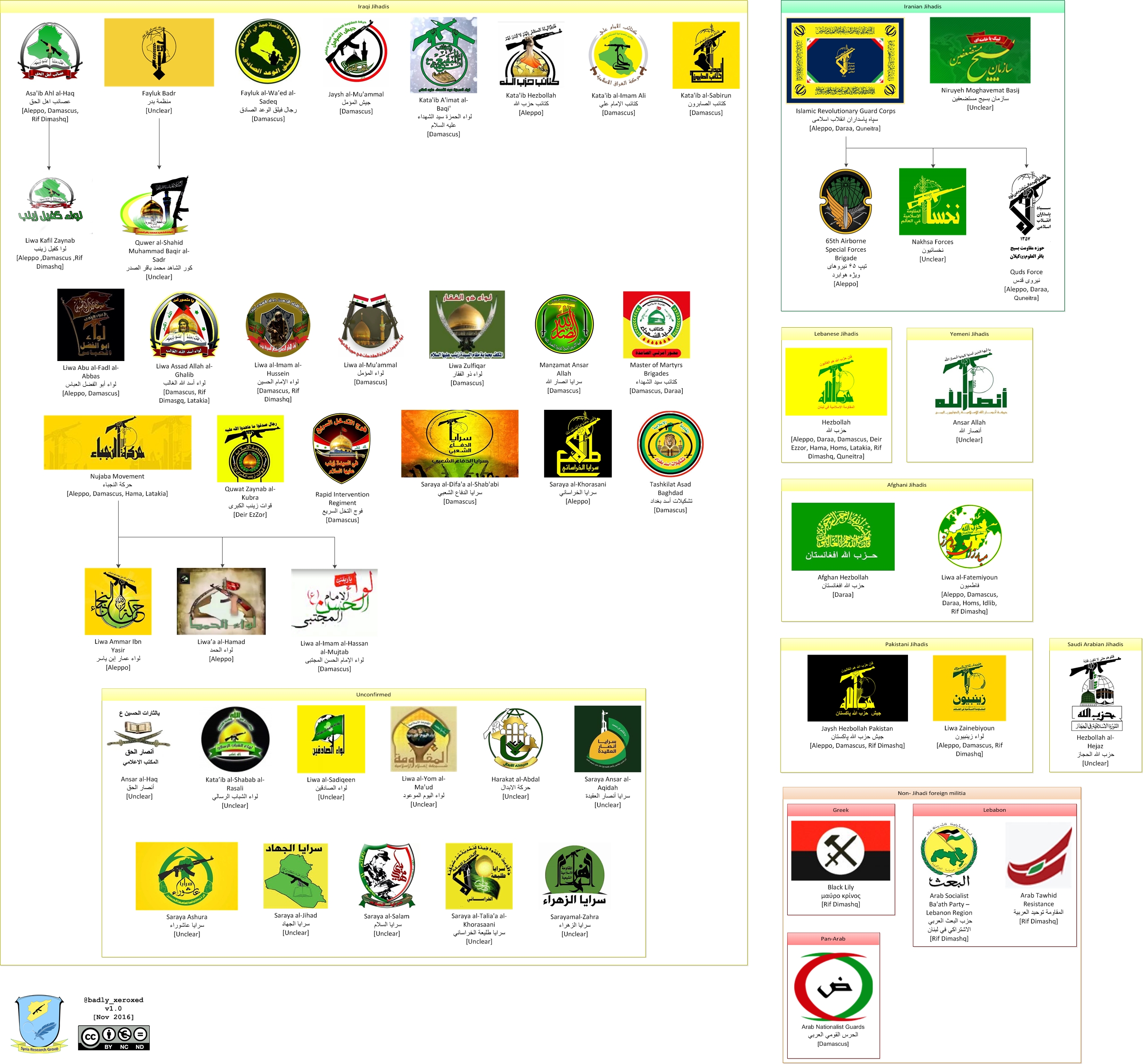
Infographic displaying external Shi’ite Jihadis and other foreign fighters in the Syrian Civil War, click the graphic to see it in full resolution
The ongoing Shi’te Jihad in Syria has been overshadowed in the media by the Sunni Jihad represented in its most extreme form by ISIS [i.e. the self-proclaimed Islamic State] and the Syrian Al Qaeda affiliate Jabhat al-Nusra and its successor group Jabhat Fateh al-Sham. Avi Dichter, the chair of Israel’s foreign affairs and defense committee, has stated that Iranian-backed forces fighting on behalf of Assad amounted to “a foreign legion of some 25,000 militants, most of whom have come from Afghanistan and Pakistan,” further stating that “they are fighting in Syria only against the rebels and not against ISIS.” The following are the known figures of KIA Shi’ite Jihadis in Syria:
- Lebanese Hezbollah: ≥ 1029
- Shi’ite Afghan: ≥ 508
- Iranian IRGC and regular military: ≥ 463
- Shi’ite Pakistani: ≥ 123
- Shi’ite Iraqi: ≥ 80
Although the topic is generally understudied, an excellent report on this subject has been published, Phillip Smyth’s The Shiite Jihad in Syria and Its Regional Effects. However, while this Jihad is not the focus of this report, it is key to understanding the growing extremism fostered among the militias of the Assad regime. A notable and perhaps unexpected example is the NDF—from the very beginning, Iran’s Qasem Suleimani took a direct role in the creation of the NDF, one of the earliest examples of Iran taking a lead at the local level in structuring and backing Assad regime forces. IRGC Commander Mohamad Ali Jafari even claimed that the NDF was modeled after Iran’s Basij paramilitary forces. This is relevant as several of the militia we have mention claim some degree of affiliation with the NDF.
Of particular note, Iraqi Jihadi group Rapid Intervention Regiment formed an “istishhadi” [martyrdom] contingent in February 2015.
In addition to these many Shi’ite Jihadi groups, several non-Jihadi political groups from Lebanon have been active including the Lebanese Ba’ath Party and the relatively obscure Arab Tawhid Resistance as well as its subgroup the Ammar bin Yasser Battalion, both affiliated with the Druze Arab Tawhid Party. Other Lebanese actors such as the Lebanese Communist Party [LCP] have mobilized in regions of Lebanon that border Syria as the conflict seeps into the country, but do not fight inside Syria.
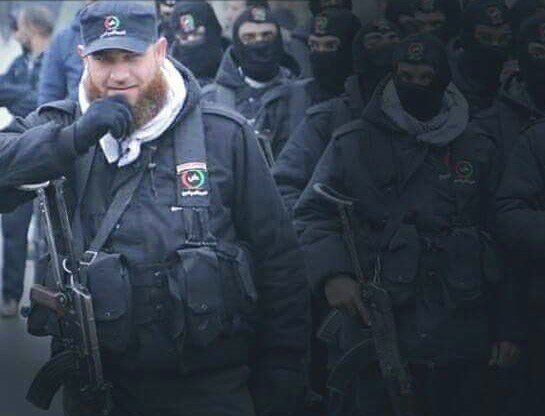
Arab Nationalist Guard, a pan-Arab milita which draws men from around the Middle East and North Africa, has been active fighting for the Assad regime, with one of their top commanders Hussein Issa [pictured above] being KIA in May 2016.
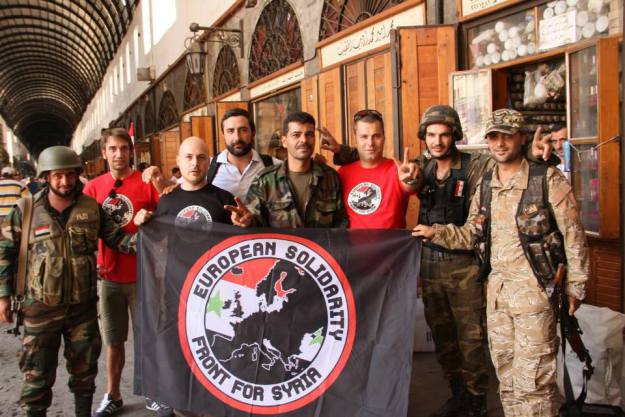
The Greek organization Black lily—a more obscure and radical group than the more famous pro-Assad Neo-Nazi group Golden Dawn, and which subscribes to the Nazi philosophy of Strasserism—have claimed to have been active fighting on the behalf of the Assad regime at the battle of al-Qusayr in 2013. Regardless of the extent to which this is true and the number of Greeks in Syria, the fact is this represents the pro-Assad aspirations of many far-right groups such as the European Solitary Front for Syria [pictured above], who have been active in Syria in a noncombatant role.
As well as these forces already listed, as of late 2016 there are persistent rumors of both Egyptian Military Forces intervening in limited numbers in Syria, as well as the threat of official Iraqi Popular Mobilization Forces [PMF] involvement in the future after IRGC Major General Mohammad Ali Jafari statements.
Shi’ite Jihadi group patches and flags
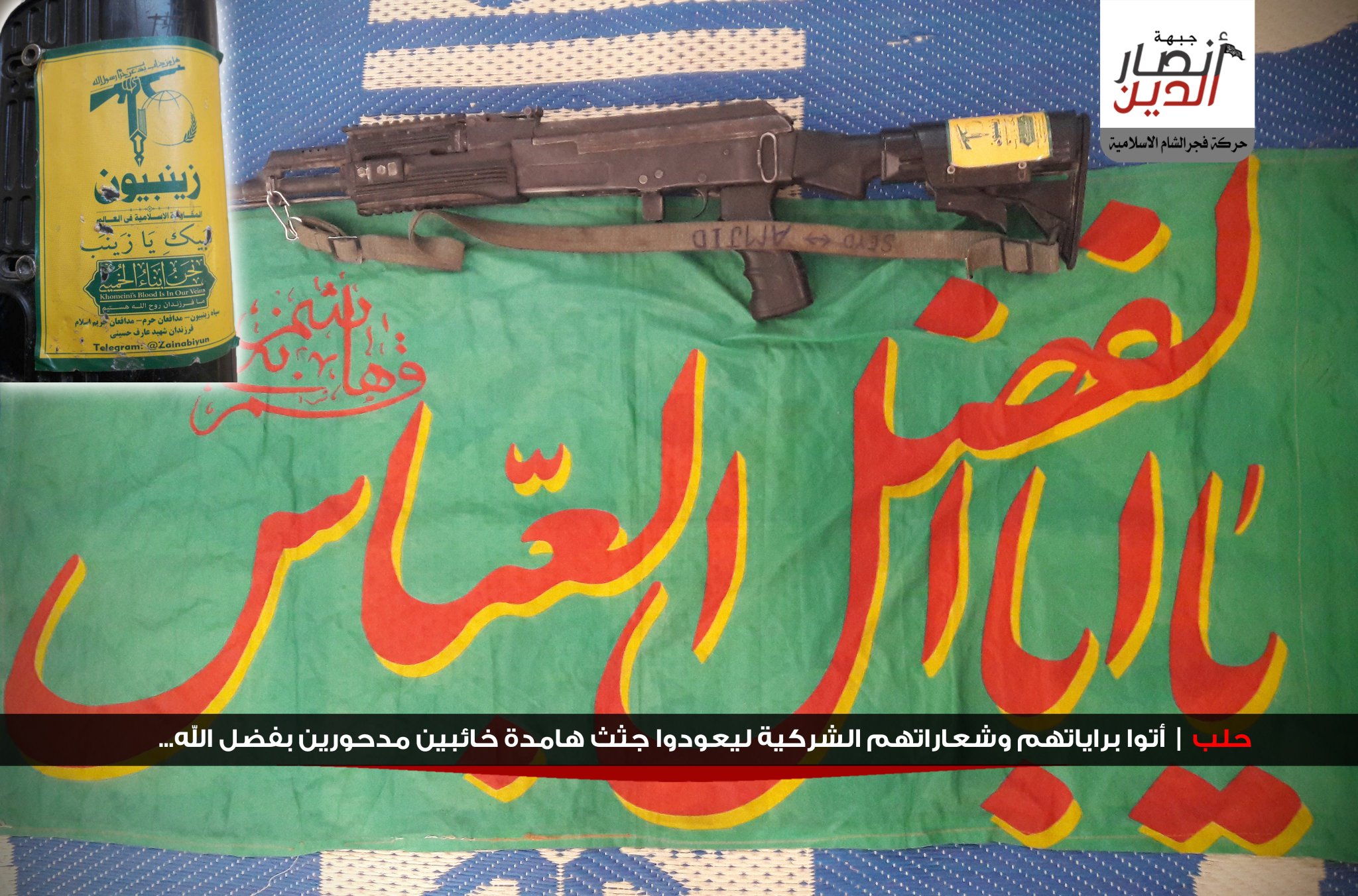
A Jabhat Ansar al-Din image from Aleppo October 2016 showing a Pakistani Liwa Zainebiyoun Shi’ite Jihadi flag with the sectarian slogan “Ya Abu Fadl al Abbas”
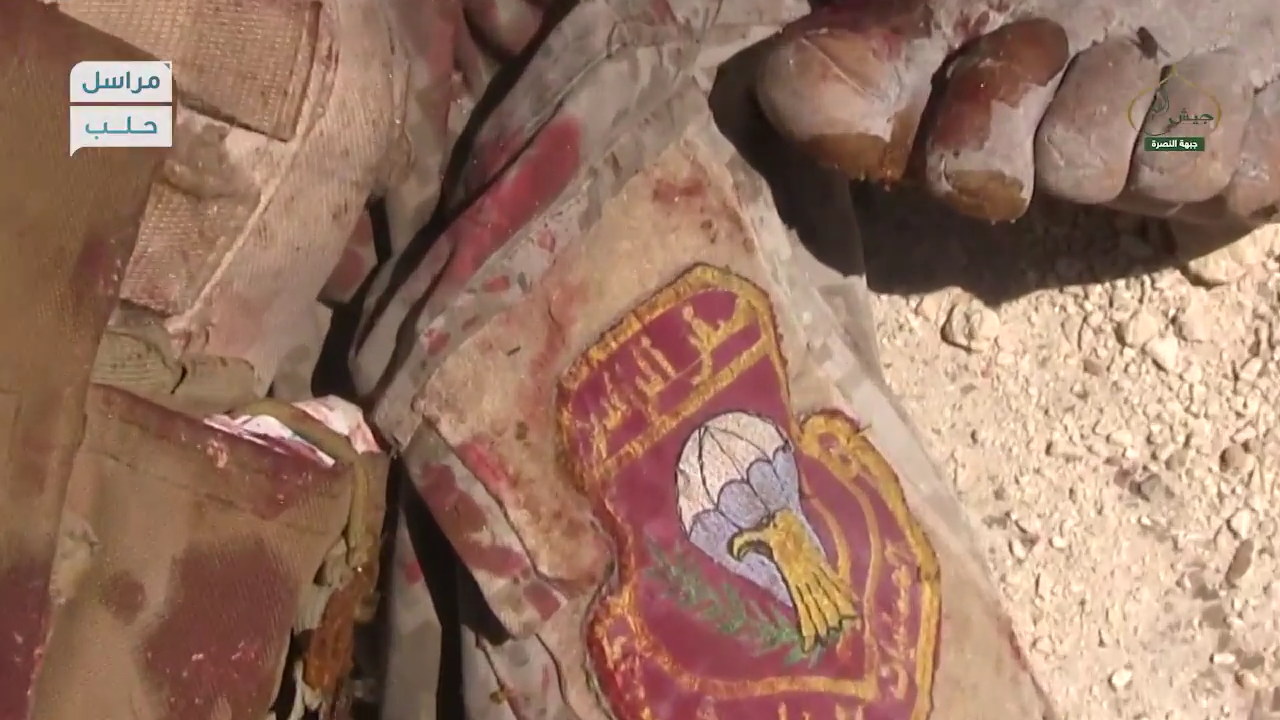
Jaysh al-Fatah screenshot displaying a deceased Shi’ite militia member in South Aleppo wearing an Iraqi Special Operations Forces patch [June 2016]
Proliferation and use of heavy weapons among Shi’ite Jihadis and foreign militia
Armor
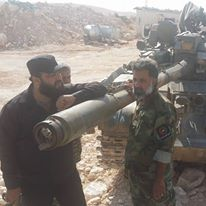
Arab Nationalist Guard tank [July 2015]
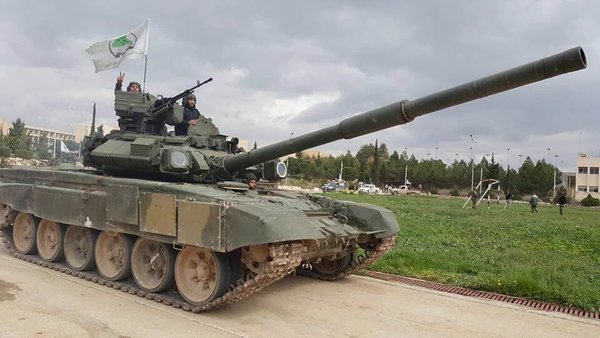
Asa’ib Ahl al-Haq operating a T-90 in Aleppo [March 2016]
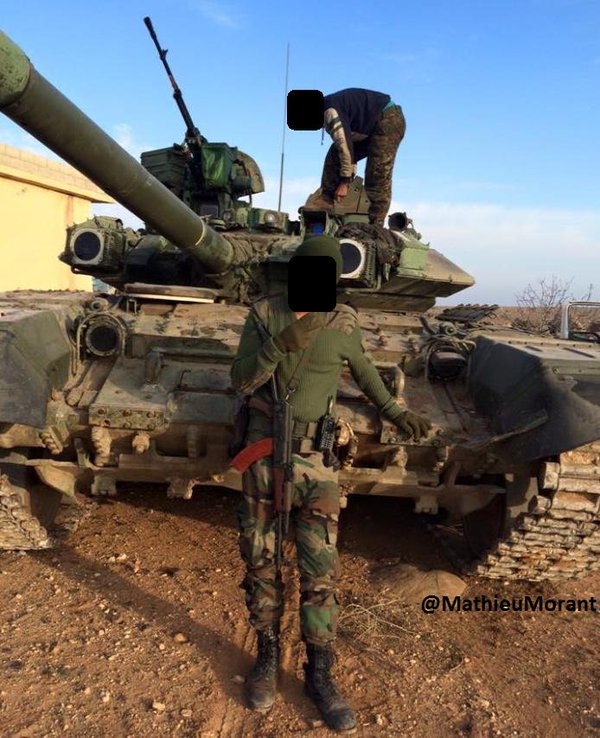
Asa’ib Ahl al-Haq with a T-90 tank, likely Aleppo [March 2016]

Hezbollah فوج المدرعات [Armored Regiment] tank—Hezbollah recently held a large parade in al-Qusayr Homs with tens of vehicles [November 2016]
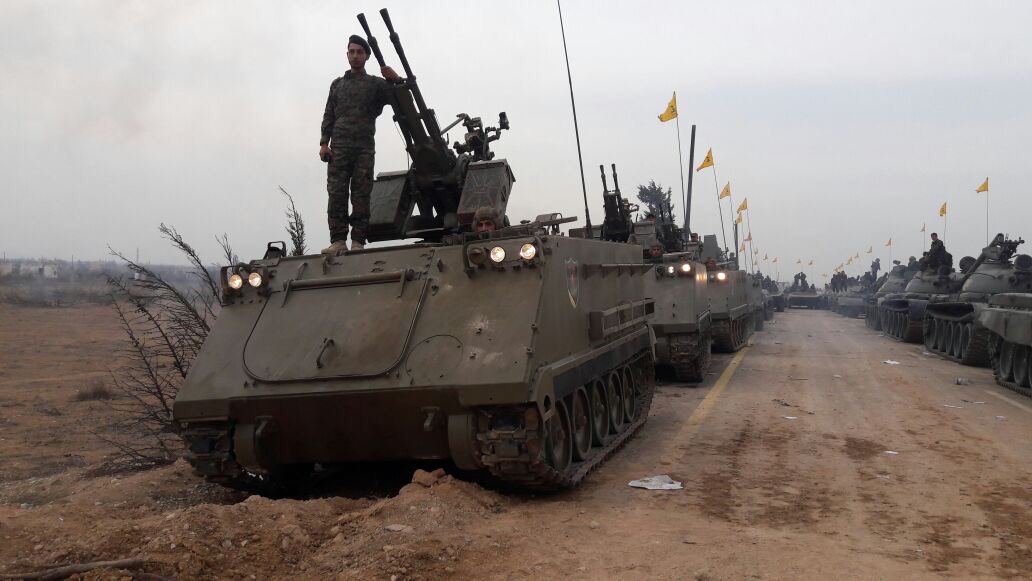
Hezbollah parade in al-Qusayr Homs also includes at least one American LAF M113 [November 2016]
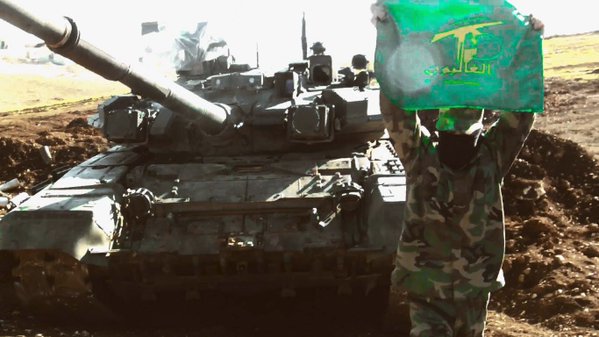
A Hezbollah affiliate flag being raised in front of a T-90, location unclear [January 2016]
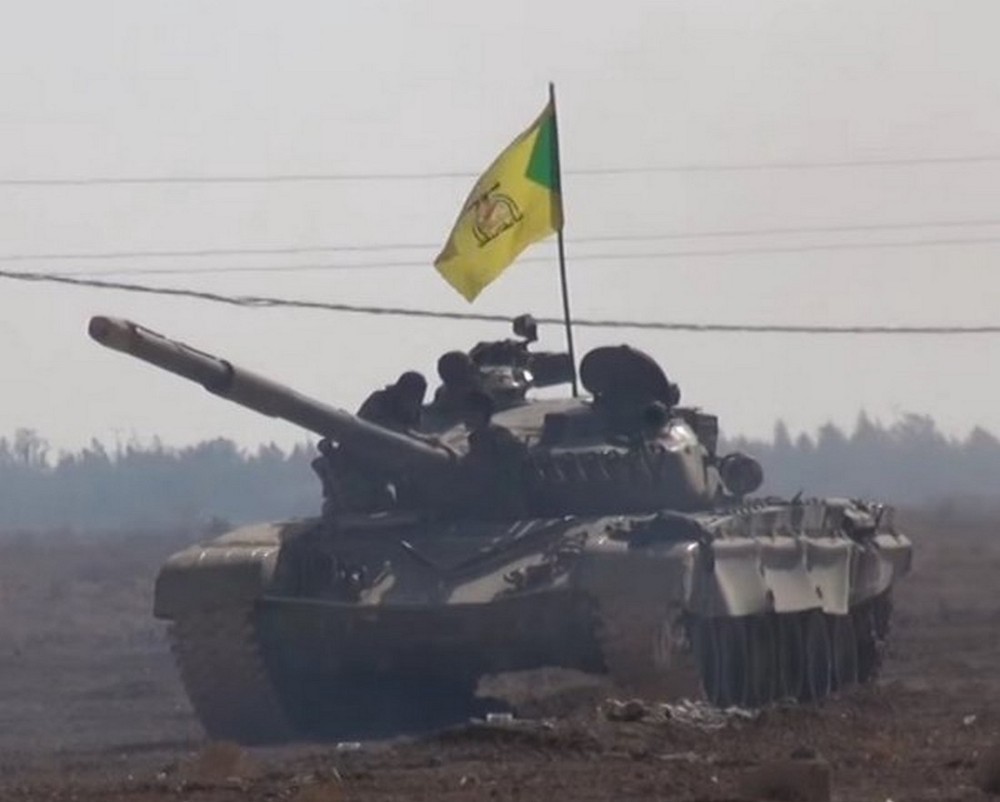
Kataib Hezbollah T-72 tank, Aleppo [November 2015]
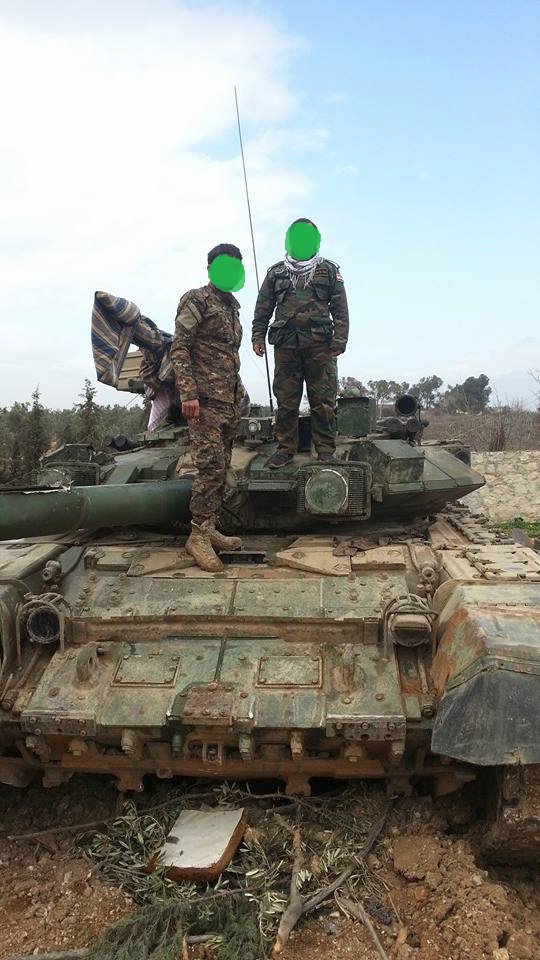
Kata’ib Sayyid al-Shuhada with a T-90 tank in Aleppo [February 2016]
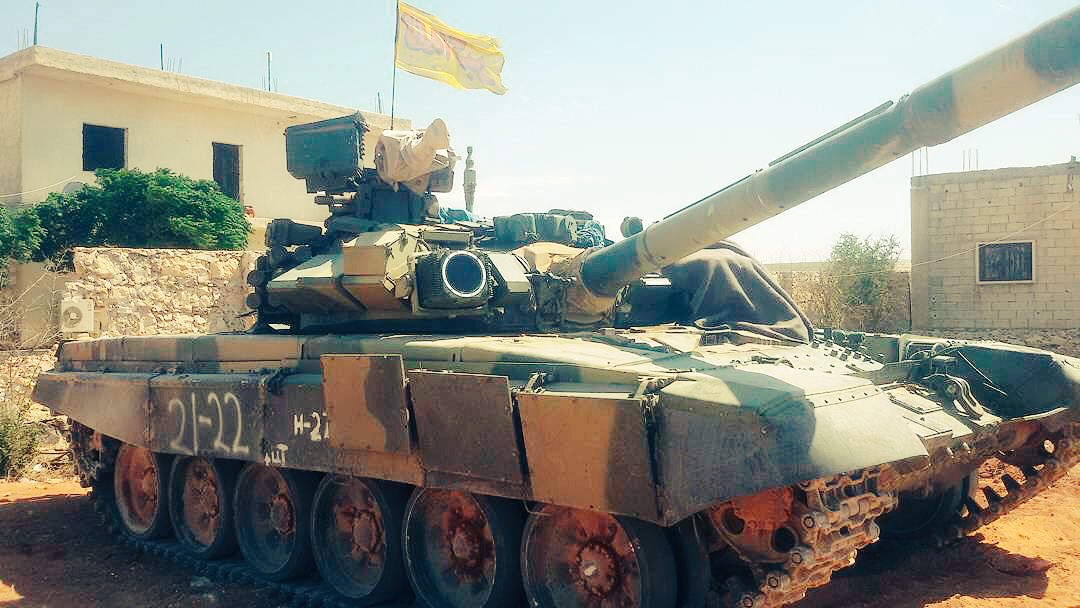
Russian T-90 tank with Shia flag, likely operated by a Shi’ite Jihadi group in Aleppo [Date unclear]
Artillery
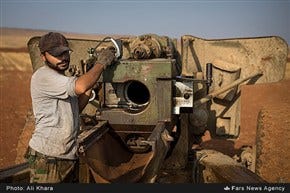

Liwa Fatemiyoun artillery South Aleppo [November 2016]
Anti-Tank Guided Missiles [ATGMs]
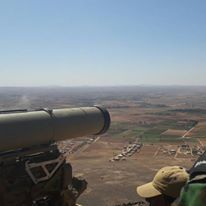
Arab Nationalist Guard operating a Metis-M ATGM, NATO designation AT-13 Saxhorn-2 [October 2016]
A European MILAN ATGM being used by Hezbollah in Western Qalamoun, seen here in Al-Manar footage: this is significant as the European Union—where the MILAN originates from—designates Hezbollah’s military wing seen in the video as a terrorist organization [mid 2015]
A Toophan ATGM seen in South Aleppo in a الاعلام الحربي مركزي video, Hezbollah’s semi-official media wing—like seemingly all Toophan strikes in Syria, the specific group using this weapon is unclear [October 2016]
Hezbollah Kornet equipped with tactical thermal camera platform, Houla Lebanon [November 2016]
Hezbollah displaying tens of Kornet ATGMs in al-Qusayr Homs [November 2016]
Conclusion
It is clear that Syrian loyalist militias are playing an increasingly large role in fighting for the Assad Regime. What is perhaps most interesting, is that while loyalist militias have existed since the early days of the war, the “militiafication” of loyalist Syrian forces has only seemed to really pick up steam in the past two years. There appears to have been a large increase in the number, size, and strength of loyalist militias from 2015 through 2016. This is likely for several intertwined reasons, reasons which will continue to drive this trend in the future. One, the degradation and exhaustion of the SAA after years of brutal warfare. Two, the worsening fiscal position of the regime, who more and more is having trouble scraping together the revenues and funds it needs to fight the war, let alone pay the wages needed by its soldiers or to attract replacements. Third, the increasingly dire economic situation in Syria generally, which has driven the majority of Syrians into poverty while also increasing the cost of living. Syrian men with no interest in fighting, are more and more facing the bleak question of how to feed their families, and fighting with one of the numerous private militias is often the best-paying job available—militias have the added incentive of being local (the Syrian conflict is extremely localized on all sides) and offering amnesty to the regime’s many draft dodgers. Therefore these regime militia continue to spawn at a rate comparable to that of rebel groups, with recent examples being the “Mobilization Force of Euphrates and Jazira” and the “Fifth Corps.”
Damascus will always be the single most important, and powerful, Syrian actor on the loyalist side. However, the relative power and importance of the various militias will continue to rise as the drivers pushing them do not have an immediate fix. This trend cannot be ignored, as it will have large implications for the future of Syria, and will affect any policy choices made in regard to the ongoing crisis. While the rise of criminal shabiha elements within the regime militias is of immediate concern, another threat that should be considered is the long term implications of the “Shi’ification trends” among regime militias and the danger of Iranian backed Jihadi groups in any future Syria where the regime is able to survive. While the issue of Al Qaeda presence in some quarters of rebel held Syria is often focused upon, the much greater and more viable danger would be regime held Syria becoming a regional hub for Iranian backed terrorism, enhanced and radicalized by years of conflict in the country. Furthermore, extremist political elements tolerated by the regime such as the SSNP have been empowered by the conflict, and the Assad regime’s association with the far-right in Europe and its implications beyond Syria cannot be ignored. While the West wrings its hands over the training and equipping of the FSA and its implications, an important aspect to consider is that Russia may well take the initiative and launch its own formal train and equip program to strengthen its Syria proxies among the regime militia. As stated by Syria analyst Faysal Itani, “Russia has preferred to deal with state institutions over militia, but that hasn’t always been practical due to the composition of forces fighting the insurgency“—rumors have already began regarding the Fifth Corps regime militia established a few days ago.
Thanks to Aymenn J Al-Tamimi for giving feedback and suggestions on an early version of this article, and huge thanks to John Arterbury and Type 63 for their continual help with Arabic as well as for finding new information on militia groups.
Cody Roche had no contact with Aymenn J Al-Tamimi during the writing of this article, this was dealt with entirely by Vincent Beshara. Cody Roche is not associated with and does not endorse Aymenn J Al-Tamimi’s work elsewhere.
